Overview
- Brief Narrative
- Sketch of a sleeping, topless woman at Gurs internment camp, drawn by Lili Andrieux, a German Jewish internee. Lili created over 100 detailed drawings of people and daily life in the internment camps where she was held from May 1940 - September 1942 in France. Alençon was a collection center for transport to Camp de Gurs in Vichy France. After surrendering to Nazi Germany in June 1940, France was divided into two zones: a German military occupation zone and Free France under the Vichy regime. Gurs, built in spring 1939 to hold refugees from Spain, became an internment center for Jewish refugees. Lili, originally from Berlin, moved to Paris in 1938. She was taken to Alençon in May 1940 and reached Gurs on June 4. From March 1941-September 1942, she was held in the Hotel Terminus in Marseilles waiting for a visa. She was then sent to Les Milles internment camp where she became ill with typhus. When she recovered, she escaped and, with the help of the resistance, lived in hiding until fall 1944, when the war ended in France. Lili was a translator for the US Army and US Graves Registration Command until immigrating to America in September 1946.
- Artwork Title
- Marianne Beerel - torso
- Series Title
- Gurs - 1940: Trying to Cope with the Merciless Heat - Summer 1940
- Date
-
creation:
1940
- Geography
-
creation:
Gurs (Concentration camp);
Gurs (France)
- Credit Line
- United States Holocaust Memorial Museum Collection
- Signature
- front, bottom, right, black ink : LRA 40
- Contributor
-
Artist:
Lili Andrieux
Subject: Lili Andrieux
Subject: Marianne Beerel
- Biography
-
Lili Andrieux (1914-1996) was born Lili Sophie Abraham in Berlin, Germany, to Hans (1880-1955) and Margarete (nee Landau, 1887-1963) Abraham. She had two brothers, Joachim (1912-1958) and Peter (1916-1988), and a sister, Gabriele (later Nanda, 1928-2014). The Abrahams were a wealthy, assimilated Jewish family, and Hans was a respected notary or lawyer .
On January 30, 1933, Adolf Hitler was appointed Chancellor of Germany. Anti-Jewish decrees were passed that restricted every aspect of Jewish life. Despite this, that same year, Lili became the only Jewish woman admitted to the Hochschule fur Kunsterzeichnung (the State College for Art Education) in Berlin. Admittance to the school was based on portfolio work. In September 1935, the Nazis announced the Nuremberg Laws, which excluded Jews from citizenship and prohibited them from marrying or having relations with non-Jewish persons. This likely prompted Lili’s brother, Peter, to immigrate to England in 1936 and find work in leather tanning and shoe manufacturing. In the 1930s, the other members of her family also immigrated to England, where Margarete’s brother lived. Because of the laws, Lili was not permitted to take her final exams in 1937. In 1938, she went to Paris to continue her studies at the Ranson Academie and permanently adopted the French surname Andrieux.
Britain and France declared war on Germany on September 3, 1939, two days after Germany invaded Poland. In November 1939, Lili’s brother, Peter, left England for Melbourne, Australia, and changed his name to Peter Landan. On May 7, 1940, Lili’s parents and her siblings, Joachim and Gabriele, sailed from England, to the United States. The family settled in Massachusetts, with the support of Hans Apel, a family friend from Berlin who had immigrated to the United States in 1937. Lili’s father obtained a research position at Harvard University, and Joachim worked as a gardener, farmer, and a stockman.
German forces invaded France on May 10, 1940, and the following month, France signed an armistice agreement with Germany. Germany occupied northern and western France, while southern and eastern France was governed by a French collaborationist government headquartered in the city of Vichy, suspending the constitution of the Third Republic. Soon after, Lili was taken to the transit center in Alencon, the Department of de L’Orne in Normandy. On June 4, she was transferred to Gurs internment camp in southwestern France near the Spanish border. In March 1941, Lili was moved to the Hotel Terminus du port in Marseilles, where women and children were held while waiting for visas and immigration permits. In September, she was transferred back to Gurs until November, when she was returned to the Hotel Terminus. While imprisoned, she created over 100 detailed drawings of daily domestic life, and the different groups held in the camps. An exhibit of her works was held in Aix-en-Provence in 1942, but they did not include scenes of the internment camp, as this was forbidden by camp regulations. On September 2, 1942, Lili was sent to the Family Reunion center in Les Milles internment camp, with the other women and children who had been held in hotels in Marseilles. She contracted typhus and was hospitalized in Aix-en-Provence. When she was discharged on September 26, she escaped and lived in hiding for the duration of the war with the aid of the French resistance, which she joined .
On August 24, 1944, the German forces in France surrendered. Lili remained in Aix-en-Provence, working as a translator and multi-lingual secretary for the American Army and the US Graves Registration Command. In September 1946, after receiving a scholarship for the Museum School of Fine Arts in Boston, Massachusetts, she immigrated to the US, leaving Marseille aboard the Athos II. She married Ricardo Ester (1916-2004), whom she had met in Camp de Gurs. Ricardo, born in Barcelona, was a refugee from Francisco Franco’s fascist Spain, and had been a pilot for the Republic during the Spanish Civil War (1936-1939). They settled in San Diego, California, where Lili had a career as a commercial artist. Her work was occasionally exhibited, and is owned by the Lochamei HaGhetaot and the Bibliotheque Nationale, as well as the United States Holocaust Memorial Museum.
Marianne Beerel (nee Schiff, 1911-?), was born in Breslau, Germany (now Wrocław, Poland) to Arthur (1881-1940) and Gertrude (nee Kraft, 1887-1972) Schiff. She had one sister named Verale (later Peter, 1913-1977). Arthur was a partner in a profitable business, and as a result, the family lived an affluent lifestyle. They employed two maids, a cook, a chauffeur, and other part-time helpers. In addition to their home in Breslau, they also had a country home and four pianos. Gertrude was a talented musician and piano player. Marianne and her sister began learning piano as children, and received professional lessons at age 12. The family was not very religious, but often celebrated the major Jewish holidays.
On January 30, 1933, Adolf Hitler was appointed chancellor of Germany by President Paul von Hindenburg. Under Hitler, authorities quickly began suppressing the rights and personal freedoms of Jews, and boycotting their businesses. In October 1934, Marianne married Heinz (or Heinrich) Beerel (1905-?), another native of Breslau, who Marianne had met in her teens. The couple lived as German refugees in Paris, France, where Marianne worked as a representative for a designer selling fashion belts. The marriage was not an entirely happy one, as they were impoverished, living in a furnished apartment, and Heinz accrued debt.
In 1937, Verale went to Oxford, England to work as an au pair. Following the nation-wide Kristallnacht pogrom on November 9th, 1938, Arthur was one of almost 10,000 Jewish men arrested by and imprisoned in Buchenwald concentration camp. Most of the men arrested during this time were released within three months, provided they had plans to emigrate from Germany. After his release, the family was forced by German authorities to give up their property and possessions, so Arthur and Gertrude immigrated to England, where she had extended family. A year later, Arthur was interned there as an enemy alien. The treatment and living conditions within the camps led many people to commit suicide, which Arthur did in July 1940.
Britain and France declared war on Germany on September 3, 1939, two days after Germany invaded Poland. Marianne’s husband volunteered for the French army. Instead, he was interned in a French camp and she was evicted from their apartment in Paris. In late 1939, her husband was allowed to enlist in a newly formed division of the army for refugees and was shipped to Morocco, where he remained for the duration of the war. German forces invaded France on May 10, 1940, and an American business associate, Charles Rendigs, tried to get Marianne a visa for the United States, but she was soon detained with 8,000 women at a sports arena in Paris. For three weeks, they were forced to stay in crowded conditions, slept on straw sacks, with little water, and poor sanitation, all under the guard of French soldiers.
Marianne was transported to Gurs internment camp, located near the Spanish border in the Pyrenees. The camp had seven sections to house women, each surrounded by barbed wire fencing. Each Barrack housed about 60 women. On June 22, France signed an armistice with Germany. Germany occupied northern and western France, while southern and eastern France was governed by a French collaborationist government headquartered in the city of Vichy, suspending the constitution of the Third Republic. Under authority of the Vichy government, a civil administration took over Gurs and released 700 prisoners interned as “enemy nationals.” The internees married to soldiers who wished to leave Gurs were allowed to do so. Undecided about where to go, Marianne, along with a small group of friends, chose to stay temporarily. During this time, she met Berlin-born artist Lili Andrieux, who had been interned in Gurs while attending school in Paris. The two remained friends until Marianne left in August.
Upon leaving Gurs, Marianne traveled with another friend to Nice. After significant hardship and difficulties, her American business associate helped arrange her visa to the United States and paid for her passage. She sailed from Vigo, Spain, to the US on February 20, 1941. She settled in New York City, and began working in her associate’s clothing factory. She divorced her husband, and in 1961, began undergraduate work at Columbia University Teacher’s College. She later earned a master’s degree and became a music therapist in New York City. Her mother, Gertrude, remained in England, and her sister, Verale, remarried and moved to Israel.
Physical Details
- Classification
-
Art
- Category
-
Drawings
- Object Type
-
Prisoners in art (lcsh)
- Genre/Form
- Art.
- Physical Description
- Black ink drawing on paper of a topless woman depicted from the torso up sleeping on her stomach with the side of her relaxed face on a patterned pillow. Her arm is bent and resting in front, leaving her side exposed. Her dark hair is brushed back, and a blanket is covering her from the waist down. She is drawn with dark, thick lines, and her hair and shadows are painted in a dark ink wash. The pillow and mattress are loosely sketched, with hatch mark shading throughout. It is initialed and signed in the lower right.
- Dimensions
- overall: Height: 11.000 inches (27.94 cm) | Width: 14.000 inches (35.56 cm)
pictorial area: Height: 6.000 inches (15.24 cm) | Width: 8.875 inches (22.543 cm) - Materials
- overall : wove paper, ink
- Inscription
- artist’s overmat removed by conservator, front, bottom, right, pencil : LRAndrieux 40
secondary support removed by conservator, front, bottom, right, pencil : Marianne Beerel
Rights & Restrictions
- Conditions on Access
- No restrictions on access
- Conditions on Use
- No restrictions on use
Keywords & Subjects
- Topical Term
- Holocaust, Jewish (1939-1945)--France. Holocaust, Jewish (1939-1945), in art. Jewish women artists. Prisoners as artists--France. Women prisoners--France. World War, 1939-1945--Prisoners and prisons--Pictorial works. France--History--German occupation, 1940-1945--Prisoners & prisons--Pictorial works.
- Geographic Name
- Gurs (France) Marseille (France) Les Milles (France)
- Personal Name
- Andrieux, Lili (1914-1996)
- Corporate Name
- Gurs (Concentration camp) Les Milles (Concentration camp)
Administrative Notes
- Legal Status
- Permanent Collection
- Provenance
- The drawing was acquired by the United States Holocaust Memorial Museum in 1988.
- Funding Note
- The cataloging of this artifact has been supported by a grant from the Conference on Jewish Material Claims Against Germany.
- Record last modified:
- 2024-01-16 10:33:54
- This page:
- https://collections.ushmm.org/search/catalog/irn109
Download & Licensing
In-Person Research
- By Appointment
- Request 21 Days in Advance of Visit
- Plan a Research Visit
- Request to See This Object
Contact Us
Also in Lili Andrieux collection
The collection consists of 91 sketches by Lili Andrieux depicting life in several internment camps and collection centers in France from 1941-1942: Camp de Gurs 1940 - 1941; Police Center Hotel Terminus du Port, Marseille - 1942; Les Milles - 1942.
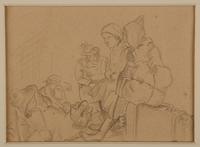
Two-sided drawing of women awaiting transport and at Gurs internment camp by a German Jewish internee
Object
Two-sided pencil drawing of women at Alençon transit center and women at Gurs internment camp, drawn by Lili Andrieux, a German Jewish internee. Lili created over 100 detailed drawings of people and daily life in the internment camps where she was held from May 1940 - September 1942 in France. Alençon was a collection center for transport to Camp de Gurs in Vichy France. After surrendering to Nazi Germany in June 1940, France was divided into two zones: a German military occupation zone and Free France under the Vichy regime. Gurs, built in spring 1939 to hold refugees from Spain, became an internment center for Jewish refugees. Lili, originally from Berlin, moved to Paris in 1938. She was taken to Alençon in May 1940 and reached Gurs on June 4. From March 1941-September 1942, she was held in the Hotel Terminus in Marseilles waiting for a visa. She was then sent to Les Milles internment camp where she became ill with typhus. When she recovered, she escaped and, with the help of the resistance, lived in hiding until fall 1944, when the war ended in France. Lili was a translator for the US Army and US Graves Registration Command until immigrating to America in September 1946.
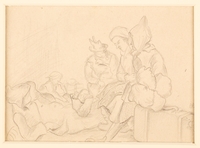
Drawing of seated women waiting for transport by a German Jewish internee
Object
Drawing of women sitting on suitcases waiting to be transported from Alencon to Camp de Gurs, drawn by Lili Andrieux, a German Jewish internee. Lili created over 100 detailed drawings of people and daily life in the internment camps where she was held from May 1940 - September 1942 in France. Alençon was a collection center for transport to Camp de Gurs in Vichy France. After surrendering to Nazi Germany in June 1940, France was divided into two zones: a German military occupation zone and Free France under the Vichy regime. Gurs, built in spring 1939 to hold refugees from Spain, became an internment center for Jewish refugees. Lili, originally from Berlin, moved to Paris in 1938. She was taken to Alençon in May 1940 and reached Gurs on June 4. From March 1941-September 1942, she was held in the Hotel Terminus in Marseilles waiting for a visa. She was then sent to Les Milles internment camp where she became ill with typhus. When she recovered, she escaped and, with the help of the resistance, lived in hiding until fall 1944, when the war ended in France. Lili was a translator for the US Army and US Graves Registration Command until immigrating to America in September 1946.
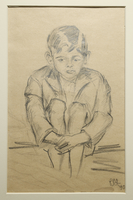
Drawing of a young male internee by a German Jewish internee
Object
Drawing of a boy, arms around his knees, imprisoned in Gurs internment camp, drawn by Lili Andrieux, a German Jewish internee. Lili created over 100 detailed drawings of people and daily life in the internment camps where she was held from May 1940 - September 1942 in France. Alençon was a collection center for transport to Camp de Gurs in Vichy France. After surrendering to Nazi Germany in June 1940, France was divided into two zones: a German military occupation zone and Free France under the Vichy regime. Gurs, built in spring 1939 to hold refugees from Spain, became an internment center for Jewish refugees. Lili, originally from Berlin, moved to Paris in 1938. She was taken to Alençon in May 1940 and reached Gurs on June 4. From March 1941-September 1942, she was held in the Hotel Terminus in Marseilles waiting for a visa. She was then sent to Les Milles internment camp where she became ill with typhus. When she recovered, she escaped and, with the help of the resistance, lived in hiding until fall 1944, when the war ended in France. Lili was a translator for the US Army and US Graves Registration Command until immigrating to America in September 1946.
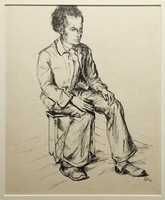
Portrait of a young adult male seated on a stool, drawn by a German Jewish internee
Object
Ink drawing of young adult male seated on a stool at Gurs internment camp, drawn by Lili Andrieux, a German Jewish internee. Lili created over 100 detailed drawings of people and daily life in the internment camps where she was held from May 1940 - September 1942 in France. Alençon was a collection center for transport to Camp de Gurs in Vichy France. After surrendering to Nazi Germany in June 1940, France was divided into two zones: a German military occupation zone and Free France under the Vichy regime. Gurs, built in spring 1939 to hold refugees from Spain, became an internment center for Jewish refugees. Lili, originally from Berlin, moved to Paris in 1938. She was taken to Alençon in May 1940 and reached Gurs on June 4. From March 1941-September 1942, she was held in the Hotel Terminus in Marseilles waiting for a visa. She was then sent to Les Milles internment camp where she became ill with typhus. When she recovered, she escaped and, with the help of the resistance, lived in hiding until fall 1944, when the war ended in France. Lili was a translator for the US Army and US Graves Registration Command until immigrating to America in September 1946.
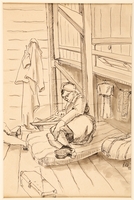
Ink drawing of female internee reading a book by a German Jewish internee
Object
Ink drawing of a woman reading a book in Gurs internment camp, drawn by Lili Andrieux, a German Jewish internee. Lili created over 100 detailed drawings of people and daily life in the internment camps where she was held from May 1940 - September 1942 in France. Alençon was a collection center for transport to Camp de Gurs in Vichy France. After surrendering to Nazi Germany in June 1940, France was divided into two zones: a German military occupation zone and Free France under the Vichy regime. Gurs, built in spring 1939 to hold refugees from Spain, became an internment center for Jewish refugees. Lili, originally from Berlin, moved to Paris in 1938. She was taken to Alençon in May 1940 and reached Gurs on June 4. From March 1941-September 1942, she was held in the Hotel Terminus in Marseilles waiting for a visa. She was then sent to Les Milles internment camp where she became ill with typhus. When she recovered, she escaped and, with the help of the resistance, lived in hiding until fall 1944, when the war ended in France. Lili was a translator for the US Army and US Graves Registration Command until immigrating to America in September 1946.
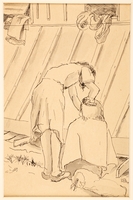
Drawing of a woman combing another woman's hair by a German Jewish internee
Object
Ink drawing of a woman combing another woman's hair in Gurs internment camp, by Lili Andrieux, a German Jewish internee. Lili created over 100 detailed drawings of people and daily life in the internment camps where she was held from May 1940 - September 1942 in France. Alençon was a collection center for transport to Camp de Gurs in Vichy France. After surrendering to Nazi Germany in June 1940, France was divided into two zones: a German military occupation zone and Free France under the Vichy regime. Gurs, built in spring 1939 to hold refugees from Spain, became an internment center for Jewish refugees. Lili, originally from Berlin, moved to Paris in 1938. She was taken to Alençon in May 1940 and reached Gurs on June 4. From March 1941-September 1942, she was held in the Hotel Terminus in Marseilles waiting for a visa. She was then sent to Les Milles internment camp where she became ill with typhus. When she recovered, she escaped and, with the help of the resistance, lived in hiding until fall 1944, when the war ended in France. Lili was a translator for the US Army and US Graves Registration Command until immigrating to America in September 1946.
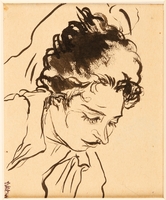
Ink drawing of woman sleeping at Gurs internment camp by a German Jewish internee
Object
Ink drawing of a sleeping woman drawn in Gurs internment camp, drawn by Lili Andrieux, a German Jewish internee. Lili created over 100 detailed drawings of people and daily life in the internment camps where she was held from May 1940 - September 1942 in France. Alençon was a collection center for transport to Camp de Gurs in Vichy France. After surrendering to Nazi Germany in June 1940, France was divided into two zones: a German military occupation zone and Free France under the Vichy regime. Gurs, built in spring 1939 to hold refugees from Spain, became an internment center for Jewish refugees. Lili, originally from Berlin, moved to Paris in 1938. She was taken to Alençon in May 1940 and reached Gurs on June 4. From March 1941-September 1942, she was held in the Hotel Terminus in Marseilles waiting for a visa. She was then sent to Les Milles internment camp where she became ill with typhus. When she recovered, she escaped and, with the help of the resistance, lived in hiding until fall 1944, when the war ended in France. Lili was a translator for the US Army and US Graves Registration Command until immigrating to America in September 1946.
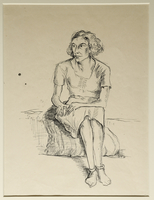
Portrait of a seated woman drawn by a German Jewish internee
Object
Ink portrait of a seated woman in Gurs internment camp, drawn by Lili Andrieux, a German Jewish internee. Lili created over 100 detailed drawings of people and daily life in the internment camps where she was held from May 1940 - September 1942 in France. Alençon was a collection center for transport to Camp de Gurs in Vichy France. After surrendering to Nazi Germany in June 1940, France was divided into two zones: a German military occupation zone and Free France under the Vichy regime. Gurs, built in spring 1939 to hold refugees from Spain, became an internment center for Jewish refugees. Lili, originally from Berlin, moved to Paris in 1938. She was taken to Alençon in May 1940 and reached Gurs on June 4. From March 1941-September 1942, she was held in the Hotel Terminus in Marseilles waiting for a visa. She was then sent to Les Milles internment camp where she became ill with typhus. When she recovered, she escaped and, with the help of the resistance, lived in hiding until fall 1944, when the war ended in France. Lili was a translator for the US Army and US Graves Registration Command until immigrating to America in September 1946.
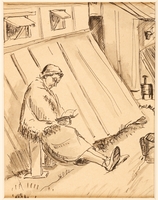
Drawing of woman reading outdoors by a German Jewish internee
Object
Ink drawing of an older woman reading a book outside drawn in Gurs internment camp by Lili Andrieux, a German Jewish internee. Lili created over 100 detailed drawings of people and daily life in the internment camps where she was held from May 1940 - September 1942 in France. Alençon was a collection center for transport to Camp de Gurs in Vichy France. After surrendering to Nazi Germany in June 1940, France was divided into two zones: a German military occupation zone and Free France under the Vichy regime. Gurs, built in spring 1939 to hold refugees from Spain, became an internment center for Jewish refugees. Lili, originally from Berlin, moved to Paris in 1938. She was taken to Alençon in May 1940 and reached Gurs on June 4. From March 1941-September 1942, she was held in the Hotel Terminus in Marseilles waiting for a visa. She was then sent to Les Milles internment camp where she became ill with typhus. When she recovered, she escaped and, with the help of the resistance, lived in hiding until fall 1944, when the war ended in France. Lili was a translator for the US Army and US Graves Registration Command until immigrating to America in September 1946.
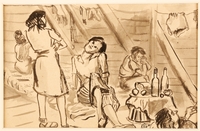
Sketch of women in their barracks by a German Jewish internee
Object
Ink drawing of women relaxing inside their barracks at Gurs internment camp by Lili Andrieux, a German Jewish internee. Lili created over 100 detailed drawings of people and daily life in the internment camps where she was held from May 1940 - September 1942 in France. Alençon was a collection center for transport to Camp de Gurs in Vichy France. After surrendering to Nazi Germany in June 1940, France was divided into two zones: a German military occupation zone and Free France under the Vichy regime. Gurs, built in spring 1939 to hold refugees from Spain, became an internment center for Jewish refugees. Lili, originally from Berlin, moved to Paris in 1938. She was taken to Alençon in May 1940 and reached Gurs on June 4. From March 1941-September 1942, she was held in the Hotel Terminus in Marseilles waiting for a visa. She was then sent to Les Milles internment camp where she became ill with typhus. When she recovered, she escaped and, with the help of the resistance, lived in hiding until fall 1944, when the war ended in France. Lili was a translator for the US Army and US Graves Registration Command until immigrating to America in September 1946.
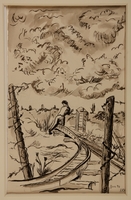
Two-sided drawing of railroad tracks and women carrying a bucket by a German Jewish internee
Object
Two ink drawings, one of railroad tracks, the other of woman carrying a bucket in Gurs internment camp by Lili Andrieux, a German Jewish internee. Lili created over 100 detailed drawings of people and daily life in the internment camps where she was held from May 1940 - September 1942 in France. Alençon was a collection center for transport to Camp de Gurs in Vichy France. After surrendering to Nazi Germany in June 1940, France was divided into two zones: a German military occupation zone and Free France under the Vichy regime. Gurs, built in spring 1939 to hold refugees from Spain, became an internment center for Jewish refugees. Lili, originally from Berlin, moved to Paris in 1938. She was taken to Alençon in May 1940 and reached Gurs on June 4. From March 1941-September 1942, she was held in the Hotel Terminus in Marseilles waiting for a visa. She was then sent to Les Milles internment camp where she became ill with typhus. When she recovered, she escaped and, with the help of the resistance, lived in hiding until fall 1944, when the war ended in France. Lili was a translator for the US Army and US Graves Registration Command until immigrating to America in September 1946.
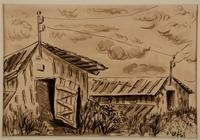
Ink drawing of two barracks surrounded by tall grass by a German Jewish internee
Object
Ink drawing of two wooden barracks in Gurs internment camp, drawn by Lili Andrieux, a German Jewish internee. Lili created over 100 detailed drawings of people and daily life in the internment camps where she was held from May 1940 - September 1942 in France. Alençon was a collection center for transport to Camp de Gurs in Vichy France. After surrendering to Nazi Germany in June 1940, France was divided into two zones: a German military occupation zone and Free France under the Vichy regime. Gurs, built in spring 1939 to hold refugees from Spain, became an internment center for Jewish refugees. Lili, originally from Berlin, moved to Paris in 1938. She was taken to Alençon in May 1940 and reached Gurs on June 4. From March 1941-September 1942, she was held in the Hotel Terminus in Marseilles waiting for a visa. She was then sent to Les Milles internment camp where she became ill with typhus. When she recovered, she escaped and, with the help of the resistance, lived in hiding until fall 1944, when the war ended in France. Lili was a translator for the US Army and US Graves Registration Command until immigrating to America in September 1946.
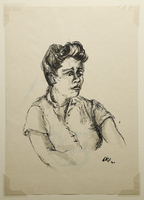
Portrait of the head of barracks by a German Jewish internee
Object
Ink drawing of a pensive, middle-aged woman in Gurs internment camp, drawn by Lili Andrieux, a German Jewish internee. Lili created over 100 detailed drawings of people and daily life in the internment camps where she was held from May 1940 - September 1942 in France. Alençon was a collection center for transport to Camp de Gurs in Vichy France. After surrendering to Nazi Germany in June 1940, France was divided into two zones: a German military occupation zone and Free France under the Vichy regime. Gurs, built in spring 1939 to hold refugees from Spain, became an internment center for Jewish refugees. Lili, originally from Berlin, moved to Paris in 1938. She was taken to Alençon in May 1940 and reached Gurs on June 4. From March 1941-September 1942, she was held in the Hotel Terminus in Marseilles waiting for a visa. She was then sent to Les Milles internment camp where she became ill with typhus. When she recovered, she escaped and, with the help of the resistance, lived in hiding until fall 1944, when the war ended in France. Lili was a translator for the US Army and US Graves Registration Command until immigrating to America in September 1946.
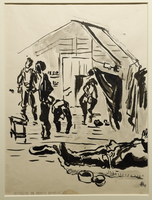
Sketch of figures inside a barrack by a German Jewish internee
Object
Ink drawing of several men inside a barrack in Gurs internment camp, drawn by Lili Andrieux, a German Jewish internee. Lili created over 100 detailed drawings of people and daily life in the internment camps where she was held from May 1940 - September 1942 in France. Alençon was a collection center for transport to Camp de Gurs in Vichy France. After surrendering to Nazi Germany in June 1940, France was divided into two zones: a German military occupation zone and Free France under the Vichy regime. Gurs, built in spring 1939 to hold refugees from Spain, became an internment center for Jewish refugees. Lili, originally from Berlin, moved to Paris in 1938. She was taken to Alençon in May 1940 and reached Gurs on June 4. From March 1941-September 1942, she was held in the Hotel Terminus in Marseilles waiting for a visa. She was then sent to Les Milles internment camp where she became ill with typhus. When she recovered, she escaped and, with the help of the resistance, lived in hiding until fall 1944, when the war ended in France. Lili was a translator for the US Army and US Graves Registration Command until immigrating to America in September 1946.
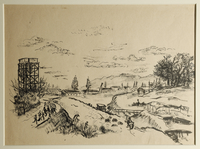
Birds-eye view of Camp de Gurs by a German Jewish internee
Object
Ink drawing of a country landscape with the guard tower and barracks of Camp de Gurs in the distance, drawn by Lili Andrieux, a German Jewish internee. Lili created over 100 detailed drawings of people and daily life in the internment camps where she was held from May 1940 - September 1942 in France. Alençon was a collection center for transport to Camp de Gurs in Vichy France. After surrendering to Nazi Germany in June 1940, France was divided into two zones: a German military occupation zone and Free France under the Vichy regime. Gurs, built in spring 1939 to hold refugees from Spain, became an internment center for Jewish refugees. Lili, originally from Berlin, moved to Paris in 1938. She was taken to Alençon in May 1940 and reached Gurs on June 4. From March 1941-September 1942, she was held in the Hotel Terminus in Marseilles waiting for a visa. She was then sent to Les Milles internment camp where she became ill with typhus. When she recovered, she escaped and, with the help of the resistance, lived in hiding until fall 1944, when the war ended in France. Lili was a translator for the US Army and US Graves Registration Command until immigrating to America in September 1946.
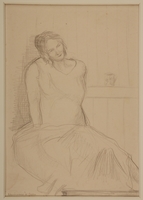
Portrait of a pregnant inmate by a German Jewish internee
Object
Ink drawing of a pregnant woman in Gurs internment, drawn by Lili Andrieux, a German Jewish internee. Lili created over 100 detailed drawings of people and daily life in the internment camps where she was held from May 1940 - September 1942 in France. Alençon was a collection center for transport to Camp de Gurs in Vichy France. After surrendering to Nazi Germany in June 1940, France was divided into two zones: a German military occupation zone and Free France under the Vichy regime. Gurs, built in spring 1939 to hold refugees from Spain, became an internment center for Jewish refugees. Lili, originally from Berlin, moved to Paris in 1938. She was taken to Alençon in May 1940 and reached Gurs on June 4. From March 1941-September 1942, she was held in the Hotel Terminus in Marseilles waiting for a visa. She was then sent to Les Milles internment camp where she became ill with typhus. When she recovered, she escaped and, with the help of the resistance, lived in hiding until fall 1944, when the war ended in France. Lili was a translator for the US Army and US Graves Registration Command until immigrating to America in September 1946.
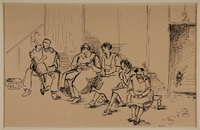
Drawing of people sitting on a bench by a German Jewish internee
Object
Ink drawing of four women and a male visitor and young girl seated on an outdoor bench drawn in Gurs internment camp, drawn by Lili Andrieux, a German Jewish internee. Lili created over 100 detailed drawings of people and daily life in the internment camps where she was held from May 1940 - September 1942 in France. Alençon was a collection center for transport to Camp de Gurs in Vichy France. After surrendering to Nazi Germany in June 1940, France was divided into two zones: a German military occupation zone and Free France under the Vichy regime. Gurs, built in spring 1939 to hold refugees from Spain, became an internment center for Jewish refugees. Lili, originally from Berlin, moved to Paris in 1938. She was taken to Alençon in May 1940 and reached Gurs on June 4. From March 1941-September 1942, she was held in the Hotel Terminus in Marseilles waiting for a visa. She was then sent to Les Milles internment camp where she became ill with typhus. When she recovered, she escaped and, with the help of the resistance, lived in hiding until fall 1944, when the war ended in France. Lili was a translator for the US Army and US Graves Registration Command until immigrating to America in September 1946.
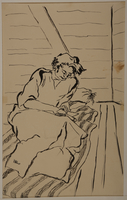
Drawing of woman reading a book on a mattress (Version II) by a German Jewish internee
Object
Ink drawing of a woman reading a book in Gurs internment camp, drawn by Lili Andrieux, a German Jewish internee. Lili created over 100 detailed drawings of people and daily life in the internment camps where she was held from May 1940 - September 1942 in France. Alençon was a collection center for transport to Camp de Gurs in Vichy France. After surrendering to Nazi Germany in June 1940, France was divided into two zones: a German military occupation zone and Free France under the Vichy regime. Gurs, built in spring 1939 to hold refugees from Spain, became an internment center for Jewish refugees. Lili, originally from Berlin, moved to Paris in 1938. She was taken to Alençon in May 1940 and reached Gurs on June 4. From March 1941-September 1942, she was held in the Hotel Terminus in Marseilles waiting for a visa. She was then sent to Les Milles internment camp where she became ill with typhus. When she recovered, she escaped and, with the help of the resistance, lived in hiding until fall 1944, when the war ended in France. Lili was a translator for the US Army and US Graves Registration Command until immigrating to America in September 1946.
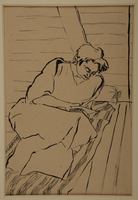
Drawing of woman reading a book on a mattress (Version I) by a German Jewish internee
Object
Ink drawing of a woman reading a book in Gurs internment camp, drawn by Lili Andrieux, a German Jewish internee. Lili created over 100 detailed drawings of people and daily life in the internment camps where she was held from May 1940 - September 1942 in France. Alençon was a collection center for transport to Camp de Gurs in Vichy France. After surrendering to Nazi Germany in June 1940, France was divided into two zones: a German military occupation zone and Free France under the Vichy regime. Gurs, built in spring 1939 to hold refugees from Spain, became an internment center for Jewish refugees. Lili, originally from Berlin, moved to Paris in 1938. She was taken to Alençon in May 1940 and reached Gurs on June 4. From March 1941-September 1942, she was held in the Hotel Terminus in Marseilles waiting for a visa. She was then sent to Les Milles internment camp where she became ill with typhus. When she recovered, she escaped and, with the help of the resistance, lived in hiding until fall 1944, when the war ended in France. Lili was a translator for the US Army and US Graves Registration Command until immigrating to America in September 1946.
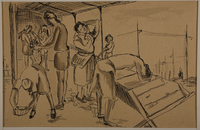
Drawing of women washing (Version I) by a German Jewish internee
Object
Ink drawing of women washing outdoors in Gurs internment camp, drawn by Lili Andrieux, a German Jewish internee. Lili created over 100 detailed drawings of people and daily life in the internment camps where she was held from May 1940 - September 1942 in France. Alençon was a collection center for transport to Camp de Gurs in Vichy France. After surrendering to Nazi Germany in June 1940, France was divided into two zones: a German military occupation zone and Free France under the Vichy regime. Gurs, built in spring 1939 to hold refugees from Spain, became an internment center for Jewish refugees. Lili, originally from Berlin, moved to Paris in 1938. She was taken to Alençon in May 1940 and reached Gurs on June 4. From March 1941-September 1942, she was held in the Hotel Terminus in Marseilles waiting for a visa. She was then sent to Les Milles internment camp where she became ill with typhus. When she recovered, she escaped and, with the help of the resistance, lived in hiding until fall 1944, when the war ended in France. Lili was a translator for the US Army and US Graves Registration Command until immigrating to America in September 1946.
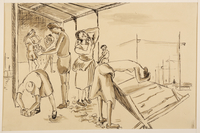
Drawing of women washing (Version II) by a German Jewish internee
Object
Ink drawing of woman washing themselves under an outdoor awning in Gurs internment camp, drawn by Lili Andrieux, a German Jewish internee. Lili created over 100 detailed drawings of people and daily life in the internment camps where she was held from May 1940 - September 1942 in France. Alençon was a collection center for transport to Camp de Gurs in Vichy France. After surrendering to Nazi Germany in June 1940, France was divided into two zones: a German military occupation zone and Free France under the Vichy regime. Gurs, built in spring 1939 to hold refugees from Spain, became an internment center for Jewish refugees. Lili, originally from Berlin, moved to Paris in 1938. She was taken to Alençon in May 1940 and reached Gurs on June 4. From March 1941-September 1942, she was held in the Hotel Terminus in Marseilles waiting for a visa. She was then sent to Les Milles internment camp where she became ill with typhus. When she recovered, she escaped and, with the help of the resistance, lived in hiding until fall 1944, when the war ended in France. Lili was a translator for the US Army and US Graves Registration Command until immigrating to America in September 1946.
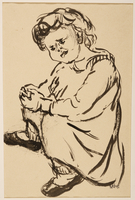
Drawing of a young boy drawn by a German Jewish internee
Object
Ink drawing of a child in Gurs internment camp, drawn by Lili Andrieux, a German Jewish internee. Lili created over 100 detailed drawings of people and daily life in the internment camps where she was held from May 1940 - September 1942 in France. Alençon was a collection center for transport to Camp de Gurs in Vichy France. After surrendering to Nazi Germany in June 1940, France was divided into two zones: a German military occupation zone and Free France under the Vichy regime. Gurs, built in spring 1939 to hold refugees from Spain, became an internment center for Jewish refugees. Lili, originally from Berlin, moved to Paris in 1938. She was taken to Alençon in May 1940 and reached Gurs on June 4. From March 1941-September 1942, she was held in the Hotel Terminus in Marseilles waiting for a visa. She was then sent to Les Milles internment camp where she became ill with typhus. When she recovered, she escaped and, with the help of the resistance, lived in hiding until fall 1944, when the war ended in France. Lili was a translator for the US Army and US Graves Registration Command until immigrating to America in September 1946.
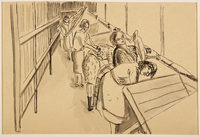
Drawing of women washing clothes in a basin by a German Jewish internee
Object
Ink drawing of women washing clothes drawn in Gurs internment camp, drawn by Lili Andrieux, a German Jewish internee. Lili created over 100 detailed drawings of people and daily life in the internment camps where she was held from May 1940 - September 1942 in France. Alençon was a collection center for transport to Camp de Gurs in Vichy France. After surrendering to Nazi Germany in June 1940, France was divided into two zones: a German military occupation zone and Free France under the Vichy regime. Gurs, built in spring 1939 to hold refugees from Spain, became an internment center for Jewish refugees. Lili, originally from Berlin, moved to Paris in 1938. She was taken to Alençon in May 1940 and reached Gurs on June 4. From March 1941-September 1942, she was held in the Hotel Terminus in Marseilles waiting for a visa. She was then sent to Les Milles internment camp where she became ill with typhus. When she recovered, she escaped and, with the help of the resistance, lived in hiding until fall 1944, when the war ended in France. Lili was a translator for the US Army and US Graves Registration Command until immigrating to America in September 1946.

Drawing of women washing clothes at a washhouse by a German Jewish internee
Object
Ink drawing of women washing clothes in Gurs internment camp, drawn by Lili Andrieux, a German Jewish internee. Lili created over 100 detailed drawings of people and daily life in the internment camps where she was held from May 1940 - September 1942 in France. Alençon was a collection center for transport to Camp de Gurs in Vichy France. After surrendering to Nazi Germany in June 1940, France was divided into two zones: a German military occupation zone and Free France under the Vichy regime. Gurs, built in spring 1939 to hold refugees from Spain, became an internment center for Jewish refugees. Lili, originally from Berlin, moved to Paris in 1938. She was taken to Alençon in May 1940 and reached Gurs on June 4. From March 1941-September 1942, she was held in the Hotel Terminus in Marseilles waiting for a visa. She was then sent to Les Milles internment camp where she became ill with typhus. When she recovered, she escaped and, with the help of the resistance, lived in hiding until fall 1944, when the war ended in France. Lili was a translator for the US Army and US Graves Registration Command until immigrating to America in September 1946.
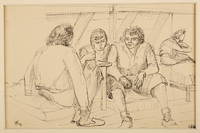
Portrait of three female inmates (Version I) by a German Jewish internee
Object
Ink portrait of three women in Gurs internment camp, drawn by Lili Andrieux, a German Jewish internee. Lili created over 100 detailed drawings of people and daily life in the internment camps where she was held from May 1940 - September 1942 in France. Alençon was a collection center for transport to Camp de Gurs in Vichy France. After surrendering to Nazi Germany in June 1940, France was divided into two zones: a German military occupation zone and Free France under the Vichy regime. Gurs, built in spring 1939 to hold refugees from Spain, became an internment center for Jewish refugees. Lili, originally from Berlin, moved to Paris in 1938. She was taken to Alençon in May 1940 and reached Gurs on June 4. From March 1941-September 1942, she was held in the Hotel Terminus in Marseilles waiting for a visa. She was then sent to Les Milles internment camp where she became ill with typhus. When she recovered, she escaped and, with the help of the resistance, lived in hiding until fall 1944, when the war ended in France. Lili was a translator for the US Army and US Graves Registration Command until immigrating to America in September 1946.
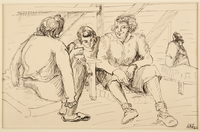
Portrait of three female inmates (Version II) by a German Jewish internee
Object
Ink portrait of three women in Gurs internment camp, drawn by Lili Andrieux, a German Jewish internee. Lili created over 100 detailed drawings of people and daily life in the internment camps where she was held from May 1940 - September 1942 in France. Alençon was a collection center for transport to Camp de Gurs in Vichy France. After surrendering to Nazi Germany in June 1940, France was divided into two zones: a German military occupation zone and Free France under the Vichy regime. Gurs, built in spring 1939 to hold refugees from Spain, became an internment center for Jewish refugees. Lili, originally from Berlin, moved to Paris in 1938. She was taken to Alençon in May 1940 and reached Gurs on June 4. From March 1941-September 1942, she was held in the Hotel Terminus in Marseilles waiting for a visa. She was then sent to Les Milles internment camp where she became ill with typhus. When she recovered, she escaped and, with the help of the resistance, lived in hiding until fall 1944, when the war ended in France. Lili was a translator for the US Army and US Graves Registration Command until immigrating to America in September 1946.
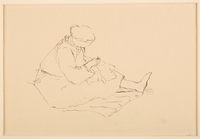
Drawing of a female prisoner sewing by a German Jewish internee
Object
Ink drawing of a women sewing in Gurs internment camp, drawn by Lili Andrieux, a German Jewish internee. Lili created over 100 detailed drawings of people and daily life in the internment camps where she was held from May 1940 - September 1942 in France. Alençon was a collection center for transport to Camp de Gurs in Vichy France. After surrendering to Nazi Germany in June 1940, France was divided into two zones: a German military occupation zone and Free France under the Vichy regime. Gurs, built in spring 1939 to hold refugees from Spain, became an internment center for Jewish refugees. Lili, originally from Berlin, moved to Paris in 1938. She was taken to Alençon in May 1940 and reached Gurs on June 4. From March 1941-September 1942, she was held in the Hotel Terminus in Marseilles waiting for a visa. She was then sent to Les Milles internment camp where she became ill with typhus. When she recovered, she escaped and, with the help of the resistance, lived in hiding until fall 1944, when the war ended in France. Lili was a translator for the US Army and US Graves Registration Command until immigrating to America in September 1946.
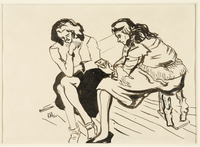
Drawing of two women sitting on stools by a German Jewish internee
Object
Ink wash drawing of two women sitting on stools in Gurs internment camp, drawn by Lili Andrieux, a German Jewish internee. Lili created over 100 detailed drawings of people and daily life in the internment camps where she was held from May 1940 - September 1942 in France. Alençon was a collection center for transport to Camp de Gurs in Vichy France. After surrendering to Nazi Germany in June 1940, France was divided into two zones: a German military occupation zone and Free France under the Vichy regime. Gurs, built in spring 1939 to hold refugees from Spain, became an internment center for Jewish refugees. Lili, originally from Berlin, moved to Paris in 1938. She was taken to Alençon in May 1940 and reached Gurs on June 4. From March 1941-September 1942, she was held in the Hotel Terminus in Marseilles waiting for a visa. She was then sent to Les Milles internment camp where she became ill with typhus. When she recovered, she escaped and, with the help of the resistance, lived in hiding until fall 1944, when the war ended in France. Lili was a translator for the US Army and US Graves Registration Command until immigrating to America in September 1946.
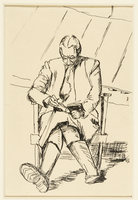
Drawing of a seated woman reading a book by a German Jewish internee
Object
Ink drawing of a woman seated in a chair reading a book in Gurs internment camp, drawn by Lili Andrieux, a German Jewish internee. Lili created over 100 detailed drawings of people and daily life in the internment camps where she was held from May 1940 - September 1942 in France. Alençon was a collection center for transport to Camp de Gurs in Vichy France. After surrendering to Nazi Germany in June 1940, France was divided into two zones: a German military occupation zone and Free France under the Vichy regime. Gurs, built in spring 1939 to hold refugees from Spain, became an internment center for Jewish refugees. Lili, originally from Berlin, moved to Paris in 1938. She was taken to Alençon in May 1940 and reached Gurs on June 4. From March 1941-September 1942, she was held in the Hotel Terminus in Marseilles waiting for a visa. She was then sent to Les Milles internment camp where she became ill with typhus. When she recovered, she escaped and, with the help of the resistance, lived in hiding until fall 1944, when the war ended in France. Lili was a translator for the US Army and US Graves Registration Command until immigrating to America in September 1946.
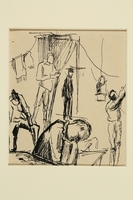
Sketch of people in an internment camp by a German Jewish internee
Object
Sketch of Camp de Gurs, drawn by Lili Andrieux, a German Jewish internee. Lili created over 100 detailed drawings of people and daily life in the internment camps where she was held from May 1940 - September 1942 in France. Alençon was a collection center for transport to Camp de Gurs in Vichy France. After surrendering to Nazi Germany in June 1940, France was divided into two zones: a German military occupation zone and Free France under the Vichy regime. Gurs, built in spring 1939 to hold refugees from Spain, became an internment center for Jewish refugees. Lili, originally from Berlin, moved to Paris in 1938. She was taken to Alençon in May 1940 and reached Gurs on June 4. From March 1941-September 1942, she was held in the Hotel Terminus in Marseilles waiting for a visa. She was then sent to Les Milles internment camp where she became ill with typhus. When she recovered, she escaped and, with the help of the resistance, lived in hiding until fall 1944, when the war ended in France. Lili was a translator for the US Army and US Graves Registration Command until immigrating to America in September 1946.
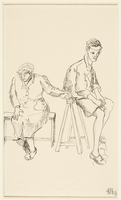
Sketch of a woman and boy by a German Jewish internee
Object
Sketch of Camp de Gurs, drawn by Lili Andrieux, a German Jewish internee. Lili created over 100 detailed drawings of people and daily life in the internment camps where she was held from May 1940 - September 1942 in France. Alençon was a collection center for transport to Camp de Gurs in Vichy France. After surrendering to Nazi Germany in June 1940, France was divided into two zones: a German military occupation zone and Free France under the Vichy regime. Gurs, built in spring 1939 to hold refugees from Spain, became an internment center for Jewish refugees. Lili, originally from Berlin, moved to Paris in 1938. She was taken to Alençon in May 1940 and reached Gurs on June 4. From March 1941-September 1942, she was held in the Hotel Terminus in Marseilles waiting for a visa. She was then sent to Les Milles internment camp where she became ill with typhus. When she recovered, she escaped and, with the help of the resistance, lived in hiding until fall 1944, when the war ended in France. Lili was a translator for the US Army and US Graves Registration Command until immigrating to America in September 1946.
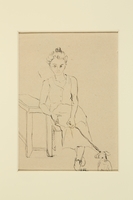
Sketch of a woman and dog by a German Jewish internee
Object
Sketch of Camp de Gurs, drawn by Lili Andrieux, a German Jewish internee. Lili created over 100 detailed drawings of people and daily life in the internment camps where she was held from May 1940 - September 1942 in France. Alençon was a collection center for transport to Camp de Gurs in Vichy France. After surrendering to Nazi Germany in June 1940, France was divided into two zones: a German military occupation zone and Free France under the Vichy regime. Gurs, built in spring 1939 to hold refugees from Spain, became an internment center for Jewish refugees. Lili, originally from Berlin, moved to Paris in 1938. She was taken to Alençon in May 1940 and reached Gurs on June 4. From March 1941-September 1942, she was held in the Hotel Terminus in Marseilles waiting for a visa. She was then sent to Les Milles internment camp where she became ill with typhus. When she recovered, she escaped and, with the help of the resistance, lived in hiding until fall 1944, when the war ended in France. Lili was a translator for the US Army and US Graves Registration Command until immigrating to America in September 1946.
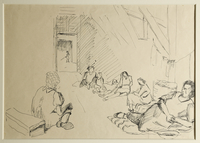
Drawing of women sitting inside barracks by a German Jewish internee
Object
Ink drawing of two women sitting on stools in Gurs internment camp, drawn by Lili Andrieux, a German Jewish internee. Lili created over 100 detailed drawings of people and daily life in the internment camps where she was held from May 1940 - September 1942 in France. Alençon was a collection center for transport to Camp de Gurs in Vichy France. After surrendering to Nazi Germany in June 1940, France was divided into two zones: a German military occupation zone and Free France under the Vichy regime. Gurs, built in spring 1939 to hold refugees from Spain, became an internment center for Jewish refugees. Lili, originally from Berlin, moved to Paris in 1938. She was taken to Alençon in May 1940 and reached Gurs on June 4. From March 1941-September 1942, she was held in the Hotel Terminus in Marseilles waiting for a visa. She was then sent to Les Milles internment camp where she became ill with typhus. When she recovered, she escaped and, with the help of the resistance, lived in hiding until fall 1944, when the war ended in France. Lili was a translator for the US Army and US Graves Registration Command until immigrating to America in September 1946.
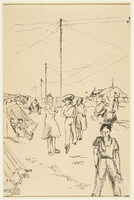
Drawing of people outside the barracks by an inmate at Gurs internment camp
Object
Sketch of an outdoor scene at Gurs internment camp, drawn by Lili Andrieux, a German Jewish internee. Lili created over 100 detailed drawings of people and daily life in the internment camps where she was held from May 1940 - September 1942 in France. Alençon was a collection center for transport to Camp de Gurs in Vichy France. After surrendering to Nazi Germany in June 1940, France was divided into two zones: a German military occupation zone and Free France under the Vichy regime. Gurs, built in spring 1939 to hold refugees from Spain, became an internment center for Jewish refugees. Lili, originally from Berlin, moved to Paris in 1938. She was taken to Alençon in May 1940 and reached Gurs on June 4. From March 1941-September 1942, she was held in the Hotel Terminus in Marseilles waiting for a visa. She was then sent to Les Milles internment camp where she became ill with typhus. When she recovered, she escaped and, with the help of the resistance, lived in hiding until fall 1944, when the war ended in France. Lili was a translator for the US Army and US Graves Registration Command until immigrating to America in September 1946.
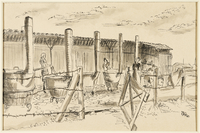
Drawing of women cooking outdoors by a German Jewish internee
Object
Sketch of women cooking in Gurs internment camp, drawn by Lili Andrieux, a German Jewish internee. Lili created over 100 detailed drawings of people and daily life in the internment camps where she was held from May 1940 - September 1942 in France. Alençon was a collection center for transport to Camp de Gurs in Vichy France. After surrendering to Nazi Germany in June 1940, France was divided into two zones: a German military occupation zone and Free France under the Vichy regime. Gurs, built in spring 1939 to hold refugees from Spain, became an internment center for Jewish refugees. Lili, originally from Berlin, moved to Paris in 1938. She was taken to Alençon in May 1940 and reached Gurs on June 4. From March 1941-September 1942, she was held in the Hotel Terminus in Marseilles waiting for a visa. She was then sent to Les Milles internment camp where she became ill with typhus. When she recovered, she escaped and, with the help of the resistance, lived in hiding until fall 1944, when the war ended in France. Lili was a translator for the US Army and US Graves Registration Command until immigrating to America in September 1946.
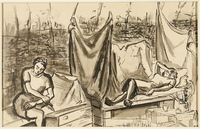
Drawing of women on outdoor benches by a German Jewish internee
Object
Sketch of two women sitting outdoors at Gurs internment camp, drawn by Lili Andrieux, a German Jewish internee. Lili created over 100 detailed drawings of people and daily life in the internment camps where she was held from May 1940 - September 1942 in France. Alençon was a collection center for transport to Camp de Gurs in Vichy France. After surrendering to Nazi Germany in June 1940, France was divided into two zones: a German military occupation zone and Free France under the Vichy regime. Gurs, built in spring 1939 to hold refugees from Spain, became an internment center for Jewish refugees. Lili, originally from Berlin, moved to Paris in 1938. She was taken to Alençon in May 1940 and reached Gurs on June 4. From March 1941-September 1942, she was held in the Hotel Terminus in Marseilles waiting for a visa. She was then sent to Les Milles internment camp where she became ill with typhus. When she recovered, she escaped and, with the help of the resistance, lived in hiding until fall 1944, when the war ended in France. Lili was a translator for the US Army and US Graves Registration Command until immigrating to America in September 1946.
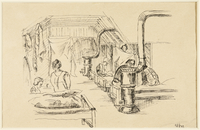
Two-sided drawing of women in barracks and woman doubled over by a German Jewish internee
Object
Two-sided drawing of women in Gurs internment camp, drawn by Lili Andrieux, a German Jewish internee. Lili created over 100 detailed drawings of people and daily life in the internment camps where she was held from May 1940 - September 1942 in France. Alençon was a collection center for transport to Camp de Gurs in Vichy France. After surrendering to Nazi Germany in June 1940, France was divided into two zones: a German military occupation zone and Free France under the Vichy regime. Gurs, built in spring 1939 to hold refugees from Spain, became an internment center for Jewish refugees. Lili, originally from Berlin, moved to Paris in 1938. She was taken to Alençon in May 1940 and reached Gurs on June 4. From March 1941-September 1942, she was held in the Hotel Terminus in Marseilles waiting for a visa. She was then sent to Les Milles internment camp where she became ill with typhus. When she recovered, she escaped and, with the help of the resistance, lived in hiding until fall 1944, when the war ended in France. Lili was a translator for the US Army and US Graves Registration Command until immigrating to America in September 1946.
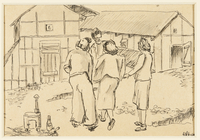
Drawing of women gathered outside of buildings by a German Jewish internee
Object
Sketch of an outdoor scene at Gurs internment camp, drawn by Lili Andrieux, a German Jewish internee. Lili created over 100 detailed drawings of people and daily life in the internment camps where she was held from May 1940 - September 1942 in France. Alençon was a collection center for transport to Camp de Gurs in Vichy France. After surrendering to Nazi Germany in June 1940, France was divided into two zones: a German military occupation zone and Free France under the Vichy regime. Gurs, built in spring 1939 to hold refugees from Spain, became an internment center for Jewish refugees. Lili, originally from Berlin, moved to Paris in 1938. She was taken to Alençon in May 1940 and reached Gurs on June 4. From March 1941-September 1942, she was held in the Hotel Terminus in Marseilles waiting for a visa. She was then sent to Les Milles internment camp where she became ill with typhus. When she recovered, she escaped and, with the help of the resistance, lived in hiding until fall 1944, when the war ended in France. Lili was a translator for the US Army and US Graves Registration Command until immigrating to America in September 1946.
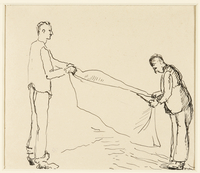
Drawing of two men folding a blanket by a German Jewish internee
Object
Sketch of two men at Gurs internment camp, drawn by Lili Andrieux, a German Jewish internee. Lili created over 100 detailed drawings of people and daily life in the internment camps where she was held from May 1940 - September 1942 in France. Alençon was a collection center for transport to Camp de Gurs in Vichy France. After surrendering to Nazi Germany in June 1940, France was divided into two zones: a German military occupation zone and Free France under the Vichy regime. Gurs, built in spring 1939 to hold refugees from Spain, became an internment center for Jewish refugees. Lili, originally from Berlin, moved to Paris in 1938. She was taken to Alençon in May 1940 and reached Gurs on June 4. From March 1941-September 1942, she was held in the Hotel Terminus in Marseilles waiting for a visa. She was then sent to Les Milles internment camp where she became ill with typhus. When she recovered, she escaped and, with the help of the resistance, lived in hiding until fall 1944, when the war ended in France. Lili was a translator for the US Army and US Graves Registration Command until immigrating to America in September 1946.
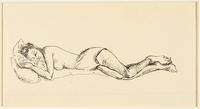
Drawing of a sleeping seminude woman sleeping on her side by a German Jewish internee
Object
Sketch of a sleeping, seminude woman at Gurs internment camp, drawn by Lili Andrieux, a German Jewish internee. Lili created over 100 detailed drawings of people and daily life in the internment camps where she was held from May 1940 - September 1942 in France. Alençon was a collection center for transport to Camp de Gurs in Vichy France. After surrendering to Nazi Germany in June 1940, France was divided into two zones: a German military occupation zone and Free France under the Vichy regime. Gurs, built in spring 1939 to hold refugees from Spain, became an internment center for Jewish refugees. Lili, originally from Berlin, moved to Paris in 1938. She was taken to Alençon in May 1940 and reached Gurs on June 4. From March 1941-September 1942, she was held in the Hotel Terminus in Marseilles waiting for a visa. She was then sent to Les Milles internment camp where she became ill with typhus. When she recovered, she escaped and, with the help of the resistance, lived in hiding until fall 1944, when the war ended in France. Lili was a translator for the US Army and US Graves Registration Command until immigrating to America in September 1946.
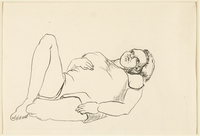
Drawing of a heavyset woman laying on her back by a German Jewish internee
Object
Sketch of a heavyset woman in Gurs internment camp, drawn by Lili Andrieux, a German Jewish internee. Lili created over 100 detailed drawings of people and daily life in the internment camps where she was held from May 1940 - September 1942 in France. Alençon was a collection center for transport to Camp de Gurs in Vichy France. After surrendering to Nazi Germany in June 1940, France was divided into two zones: a German military occupation zone and Free France under the Vichy regime. Gurs, built in spring 1939 to hold refugees from Spain, became an internment center for Jewish refugees. Lili, originally from Berlin, moved to Paris in 1938. She was taken to Alençon in May 1940 and reached Gurs on June 4. From March 1941-September 1942, she was held in the Hotel Terminus in Marseilles waiting for a visa. She was then sent to Les Milles internment camp where she became ill with typhus. When she recovered, she escaped and, with the help of the resistance, lived in hiding until fall 1944, when the war ended in France. Lili was a translator for the US Army and US Graves Registration Command until immigrating to America in September 1946.
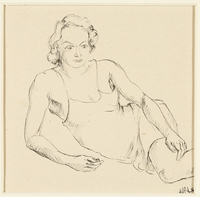
Portrait of lounging woman wearing a slip by a German Jewish internee
Object
Sketch of a woman in Gurs internment camp, drawn by Lili Andrieux, a German Jewish internee. Lili created over 100 detailed drawings of people and daily life in the internment camps where she was held from May 1940 - September 1942 in France. Alençon was a collection center for transport to Camp de Gurs in Vichy France. After surrendering to Nazi Germany in June 1940, France was divided into two zones: a German military occupation zone and Free France under the Vichy regime. Gurs, built in spring 1939 to hold refugees from Spain, became an internment center for Jewish refugees. Lili, originally from Berlin, moved to Paris in 1938. She was taken to Alençon in May 1940 and reached Gurs on June 4. From March 1941-September 1942, she was held in the Hotel Terminus in Marseilles waiting for a visa. She was then sent to Les Milles internment camp where she became ill with typhus. When she recovered, she escaped and, with the help of the resistance, lived in hiding until fall 1944, when the war ended in France. Lili was a translator for the US Army and US Graves Registration Command until immigrating to America in September 1946.
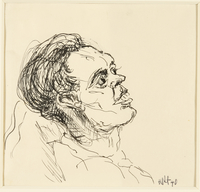
Portrait of sick man leaning back on pillow by a German Jewish internee
Object
Profile of a sick man in Gurs internment camp, drawn by Lili Andrieux, a German Jewish internee. Lili created over 100 detailed drawings of people and daily life in the internment camps where she was held from May 1940 - September 1942 in France. Alençon was a collection center for transport to Camp de Gurs in Vichy France. After surrendering to Nazi Germany in June 1940, France was divided into two zones: a German military occupation zone and Free France under the Vichy regime. Gurs, built in spring 1939 to hold refugees from Spain, became an internment center for Jewish refugees. Lili, originally from Berlin, moved to Paris in 1938. She was taken to Alençon in May 1940 and reached Gurs on June 4. From March 1941-September 1942, she was held in the Hotel Terminus in Marseilles waiting for a visa. She was then sent to Les Milles internment camp where she became ill with typhus. When she recovered, she escaped and, with the help of the resistance, lived in hiding until fall 1944, when the war ended in France. Lili was a translator for the US Army and US Graves Registration Command until immigrating to America in September 1946.
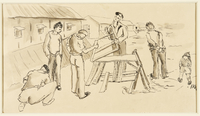
Drawing of men sawing wood outdoors by a German Jewish internee
Object
Drawing of wood sawyers in Gurs internment camp, drawn by Lili Andrieux, a German Jewish internee. Lili created over 100 detailed drawings of people and daily life in the internment camps where she was held from May 1940 - September 1942 in France. Alençon was a collection center for transport to Camp de Gurs in Vichy France. After surrendering to Nazi Germany in June 1940, France was divided into two zones: a German military occupation zone and Free France under the Vichy regime. Gurs, built in spring 1939 to hold refugees from Spain, became an internment center for Jewish refugees. Lili, originally from Berlin, moved to Paris in 1938. She was taken to Alençon in May 1940 and reached Gurs on June 4. From March 1941-September 1942, she was held in the Hotel Terminus in Marseilles waiting for a visa. She was then sent to Les Milles internment camp where she became ill with typhus. When she recovered, she escaped and, with the help of the resistance, lived in hiding until fall 1944, when the war ended in France. Lili was a translator for the US Army and US Graves Registration Command until immigrating to America in September 1946.
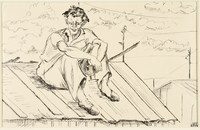
Drawing of a man sitting on a roof by a German Jewish internee
Object
Drawing of a man in Gurs internment camp, drawn by Lili Andrieux, a German Jewish internee. Lili created over 100 detailed drawings of people and daily life in the internment camps where she was held from May 1940 - September 1942 in France. Alençon was a collection center for transport to Camp de Gurs in Vichy France. After surrendering to Nazi Germany in June 1940, France was divided into two zones: a German military occupation zone and Free France under the Vichy regime. Gurs, built in spring 1939 to hold refugees from Spain, became an internment center for Jewish refugees. Lili, originally from Berlin, moved to Paris in 1938. She was taken to Alençon in May 1940 and reached Gurs on June 4. From March 1941-September 1942, she was held in the Hotel Terminus in Marseilles waiting for a visa. She was then sent to Les Milles internment camp where she became ill with typhus. When she recovered, she escaped and, with the help of the resistance, lived in hiding until fall 1944, when the war ended in France. Lili was a translator for the US Army and US Graves Registration Command until immigrating to America in September 1946.
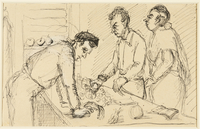
Two-sided drawing of men in a canteen and a portrait of a woman by a German Jewish internee
Object
Drawings of men in a canteen and a woman at Gurs internment camp, drawn by Lili Andrieux, a German Jewish internee. Lili created over 100 detailed drawings of people and daily life in the internment camps where she was held from May 1940 - September 1942 in France. Alençon was a collection center for transport to Camp de Gurs in Vichy France. After surrendering to Nazi Germany in June 1940, France was divided into two zones: a German military occupation zone and Free France under the Vichy regime. Gurs, built in spring 1939 to hold refugees from Spain, became an internment center for Jewish refugees. Lili, originally from Berlin, moved to Paris in 1938. She was taken to Alençon in May 1940 and reached Gurs on June 4. From March 1941-September 1942, she was held in the Hotel Terminus in Marseilles waiting for a visa. She was then sent to Les Milles internment camp where she became ill with typhus. When she recovered, she escaped and, with the help of the resistance, lived in hiding until fall 1944, when the war ended in France. Lili was a translator for the US Army and US Graves Registration Command until immigrating to America in September 1946.
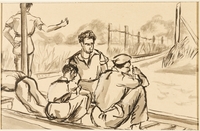
Drawing of five men near train tracks by a German Jewish internee
Object
Ink drawing of five men taking a break at Gurs internment camp, drawn by Lili Andrieux, a German Jewish internee. Lili created over 100 detailed drawings of people and daily life in the internment camps where she was held from May 1940 - September 1942 in France. Alençon was a collection center for transport to Camp de Gurs in Vichy, France. After surrendering to Nazi Germany in June 1940, France was divided into two zones: a German military occupation zone and Free France under the Vichy regime. Gurs, built in spring 1939 to hold refugees from Spain, became an internment center for Jewish refugees. Lili, originally from Berlin, moved to Paris in 1938. She was taken to Alençon in May 1940 and reached Gurs on June 4. From March 1941-September 1942, she was held in the Hotel Terminus in Marseilles waiting for a visa. Lili was then sent to Les Milles internment camp where she became ill with typhus. After recovering, she escaped with the help of the resistance, and lived in hiding until fall 1944, when the war ended in France. Lili was a translator for the US Army and US Graves Registration Command until immigrating to America in September 1946.
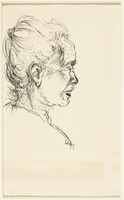
Two-sided drawing of a portrait of a woman and several abstract portraits by a German Jewish internee
Object
Double-sided ink drawing of a realistic old woman on one side and 10 abstract portraits on the opposite side, drawn by Lili Andrieux, a German Jewish internee while detained in the Hotel Terminus du port in Marseilles, France. Lili created over 100 detailed drawings of people and daily life in the internment camps where she was held from May 1940 - September 1942 in France. Alençon was a collection center for transport to Camp de Gurs in Vichy, France. After surrendering to Nazi Germany in June 1940, France was divided into two zones: a German military occupation zone and Free France under the Vichy regime. Gurs, built in spring 1939 to hold refugees from Spain, became an internment center for Jewish refugees. Lili, originally from Berlin, moved to Paris in 1938. She was taken to Alençon in May 1940 and reached Gurs on June 4. From March 1941-September 1942, she was held in the Hotel Terminus waiting for a visa. Lili was then sent to Les Milles internment camp where she became ill with typhus. After recovering, she escaped with the help of the resistance, and lived in hiding until fall 1944, when the war ended in France. Lili was a translator for the US Army and US Graves Registration Command until immigrating to America in September 1946.
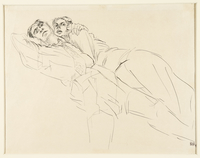
Drawing of a couple by a German Jewish internee
Object
Ink drawing of a couple in Les Milles internment camp, drawn by Lili Andrieux, a German Jewish internee. Lili created over 100 detailed drawings of people and daily life in the internment camps where she was held from May 1940 - September 1942 in France. Alençon was a collection center for transport to Camp de Gurs in Vichy, France. After surrendering to Nazi Germany in June 1940, France was divided into two zones: a German military occupation zone and Free France under the Vichy regime. Gurs, built in spring 1939 to hold refugees from Spain, became an internment center for Jewish refugees. Lili, originally from Berlin, moved to Paris in 1938. She was taken to Alençon in May 1940 and reached Gurs on June 4. From March 1941-September 1942, she was held in the Hotel Terminus waiting for a visa. Lili was then sent to Les Milles where she became ill with typhus. After recovering, she escaped with the help of the resistance, and lived in hiding until fall 1944, when the war ended in France. Lili was a translator for the US Army and US Graves Registration Command until immigrating to America in September 1946.
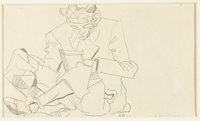
Two-sided drawing of a man reading and two figures sitting by a German Jewish internee
Object
Double-sided pencil drawing of inmates in Les Milles internment camp, drawn by Lili Andrieux, a German Jewish internee. Lili created over 100 detailed drawings of people and daily life in the internment camps where she was held from May 1940 - September 1942 in France. Alençon was a collection center for transport to Camp de Gurs in Vichy, France. After surrendering to Nazi Germany in June 1940, France was divided into two zones: a German military occupation zone and Free France under the Vichy regime. Gurs, built in spring 1939 to hold refugees from Spain, became an internment center for Jewish refugees. Lili, originally from Berlin, moved to Paris in 1938. She was taken to Alençon in May 1940 and reached Gurs on June 4. From March 1941-September 1942, she was held in the Hotel Terminus waiting for a visa. Lili was then sent to Les Milles where she became ill with typhus. After recovering, she escaped with the help of the resistance, and lived in hiding until fall 1944, when the war ended in France. Lili was a translator for the US Army and US Graves Registration Command until immigrating to America in September 1946.
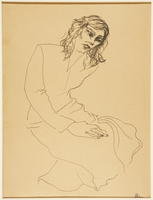
Drawing of a seated woman by a German Jewish internee
Object
Ink drawing of a seated young girl in Les Milles internment camp, drawn by Lili Andrieux, a German Jewish internee. Lili created over 100 detailed drawings of people and daily life in the internment camps where she was held from May 1940 - September 1942 in France. Alençon was a collection center for transport to Camp de Gurs in Vichy, France. After surrendering to Nazi Germany in June 1940, France was divided into two zones: a German military occupation zone and Free France under the Vichy regime. Gurs, built in spring 1939 to hold refugees from Spain, became an internment center for Jewish refugees. Lili, originally from Berlin, moved to Paris in 1938. She was taken to Alençon in May 1940 and reached Gurs on June 4. From March 1941-September 1942, she was held in the Hotel Terminus waiting for a visa. Lili was then sent to Les Milles where she became ill with typhus. After recovering, she escaped with the help of the resistance, and lived in hiding until fall 1944, when the war ended in France. Lili was a translator for the US Army and US Graves Registration Command until immigrating to America in September 1946.
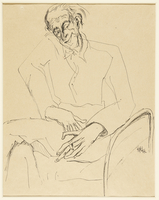
Drawing of a seated man holding a cigarette by a German Jewish internee
Object
Ink drawing of a man with a cigarette in Les Milles internment camp, drawn by Lili Andrieux, a German Jewish internee. Lili created over 100 detailed drawings of people and daily life in the internment camps where she was held from May 1940 - September 1942 in France. Alençon was a collection center for transport to Camp de Gurs in Vichy, France. After surrendering to Nazi Germany in June 1940, France was divided into two zones: a German military occupation zone and Free France under the Vichy regime. Gurs, built in spring 1939 to hold refugees from Spain, became an internment center for Jewish refugees. Lili, originally from Berlin, moved to Paris in 1938. She was taken to Alençon in May 1940 and reached Gurs on June 4. From March 1941-September 1942, she was held in the Hotel Terminus waiting for a visa. Lili was then sent to Les Milles where she became ill with typhus. After recovering, she escaped with the help of the resistance, and lived in hiding until fall 1944, when the war ended in France. Lili was a translator for the US Army and US Graves Registration Command until immigrating to America in September 1946.
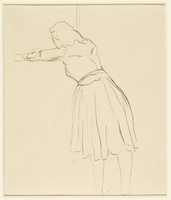
Drawing of a woman leaning against a window by a German Jewish internee
Object
Ink drawing of a woman looking out her barrack window at Gurs internment camp, drawn by Lili Andrieux, a German Jewish internee. Lili created over 100 detailed drawings of people and daily life in the internment camps where she was held from May 1940 - September 1942 in France. Alençon was a collection center for transport to Camp de Gurs in Vichy, France. After surrendering to Nazi Germany in June 1940, France was divided into two zones: a German military occupation zone and Free France under the Vichy regime. Gurs, built in spring 1939 to hold refugees from Spain, became an internment center for Jewish refugees. Lili, originally from Berlin, moved to Paris in 1938. She was taken to Alençon in May 1940 and reached Gurs on June 4. From March 1941-September 1942, she was held in the Hotel Terminus in Marseilles waiting for a visa. Lili was then sent to Les Milles internment camp where she became ill with typhus. After recovering, she escaped with the help of the resistance, and lived in hiding until fall 1944, when the war ended in France. Lili was a translator for the US Army and US Graves Registration Command until immigrating to America in September 1946.
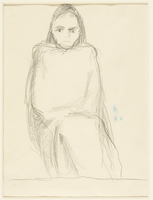
Drawing of a seated young woman in a blanket by a German Jewish internee
Object
Pencil drawing of a young woman in a cattle-car during transport from Alençon collection center to Gurs internment camp, drawn by Lili Andrieux, a German Jewish internee. Lili created over 100 detailed drawings of people and daily life in the internment camps where she was held from May 1940 - September 1942 in France. Alençon was a collection center for transport to Camp de Gurs in Vichy, France. After surrendering to Nazi Germany in June 1940, France was divided into two zones: a German military occupation zone and Free France under the Vichy regime. Gurs, built in spring 1939 to hold refugees from Spain, became an internment center for Jewish refugees. Lili, originally from Berlin, moved to Paris in 1938. She was taken to Alençon in May 1940 and reached Gurs on June 4. From March 1941-September 1942, she was held in the Hotel Terminus in Marseilles waiting for a visa. Lili was then sent to Les Milles internment camp where she became ill with typhus. After recovering, she escaped with the help of the resistance, and lived in hiding until fall 1944, when the war ended in France. Lili was a translator for the US Army and US Graves Registration Command until immigrating to America in September 1946.
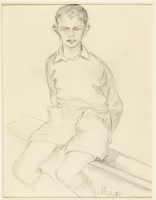
Drawing of a young boy sitting on a bench by a German Jewish internee
Object
Pencil drawing of a young boy in Gurs internment camp, drawn by Lili Andrieux, a German Jewish internee. Lili created over 100 detailed drawings of people and daily life in the internment camps where she was held from May 1940 - September 1942 in France. Alençon was a collection center for transport to Camp de Gurs in Vichy, France. After surrendering to Nazi Germany in June 1940, France was divided into two zones: a German military occupation zone and Free France under the Vichy regime. Gurs, built in spring 1939 to hold refugees from Spain, became an internment center for Jewish refugees. Lili, originally from Berlin, moved to Paris in 1938. She was taken to Alençon in May 1940 and reached Gurs on June 4. From March 1941-September 1942, she was held in the Hotel Terminus in Marseilles waiting for a visa. Lili was then sent to Les Milles internment camp where she became ill with typhus. After recovering, she escaped with the help of the resistance, and lived in hiding until fall 1944, when the war ended in France. Lili was a translator for the US Army and US Graves Registration Command until immigrating to America in September 1946.
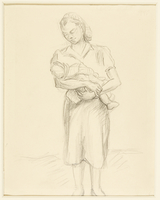
Drawing of a woman holding a baby by a German Jewish internee
Object
Pencil drawing of a Hungarian inmate holding her baby in Gurs internment camp, drawn by Lili Andrieux, a German Jewish internee. Lili created over 100 detailed drawings of people and daily life in the internment camps where she was held from May 1940 - September 1942 in France. Alençon was a collection center for transport to Camp de Gurs in Vichy, France. After surrendering to Nazi Germany in June 1940, France was divided into two zones: a German military occupation zone and Free France under the Vichy regime. Gurs, built in spring 1939 to hold refugees from Spain, became an internment center for Jewish refugees. Lili, originally from Berlin, moved to Paris in 1938. She was taken to Alençon in May 1940 and reached Gurs on June 4. From March 1941-September 1942, she was held in the Hotel Terminus in Marseilles waiting for a visa. Lili was then sent to Les Milles internment camp where she became ill with typhus. After recovering, she escaped with the help of the resistance, and lived in hiding until fall 1944, when the war ended in France. Lili was a translator for the US Army and US Graves Registration Command until immigrating to America in September 1946.
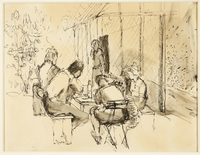
Drawing of five women in front of barracks by a German Jewish internee
Object
Ink drawing of five women near the barracks in Gurs internment camp, drawn by Lili Andrieux, a German Jewish internee. Lili created over 100 detailed drawings of people and daily life in the internment camps where she was held from May 1940 - September 1942 in France. Alençon was a collection center for transport to Camp de Gurs in Vichy, France. After surrendering to Nazi Germany in June 1940, France was divided into two zones: a German military occupation zone and Free France under the Vichy regime. Gurs, built in spring 1939 to hold refugees from Spain, became an internment center for Jewish refugees. Lili, originally from Berlin, moved to Paris in 1938. She was taken to Alençon in May 1940 and reached Gurs on June 4. From March 1941-September 1942, she was held in the Hotel Terminus in Marseilles waiting for a visa. Lili was then sent to Les Milles internment camp where she became ill with typhus. After recovering, she escaped with the help of the resistance, and lived in hiding until fall 1944, when the war ended in France. Lili was a translator for the US Army and US Graves Registration Command until immigrating to America in September 1946.
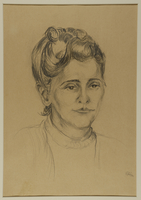
Portrait of woman with swept up hair by a German Jewish internee
Object
Portrait of a woman at Gurs internment camp, drawn by Lili Andrieux, a German Jewish internee. Lili created over 100 detailed drawings of people and daily life in the internment camps where she was held from May 1940 - September 1942 in France. Alençon was a collection center for transport to Camp de Gurs in Vichy France. After surrendering to Nazi Germany in June 1940, France was divided into two zones: a German military occupation zone and Free France under the Vichy regime. Gurs, built in spring 1939 to hold refugees from Spain, became an internment center for Jewish refugees. Lili, originally from Berlin, moved to Paris in 1938. She was taken to Alençon in May 1940 and reached Gurs on June 4. From March 1941-September 1942, she was held in the Hotel Terminus in Marseilles waiting for a visa. She was then sent to Les Milles internment camp where she became ill with typhus. When she recovered, she escaped and, with the help of the resistance, lived in hiding until fall 1944, when the war ended in France. Lili was a translator for the US Army and US Graves Registration Command until immigrating to America in September 1946.
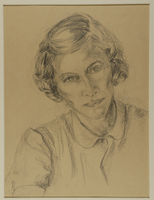
Portrait of woman with short hair by a German Jewish internee
Object
Portrait of a woman at Gurs internment camp, drawn by Lili Andrieux, a German Jewish internee. Lili created over 100 detailed drawings of people and daily life in the internment camps where she was held from May 1940 - September 1942 in France. Alençon was a collection center for transport to Camp de Gurs in Vichy France. After surrendering to Nazi Germany in June 1940, France was divided into two zones: a German military occupation zone and Free France under the Vichy regime. Gurs, built in spring 1939 to hold refugees from Spain, became an internment center for Jewish refugees. Lili, originally from Berlin, moved to Paris in 1938. She was taken to Alençon in May 1940 and reached Gurs on June 4. From March 1941-September 1942, she was held in the Hotel Terminus in Marseilles waiting for a visa. She was then sent to Les Milles internment camp where she became ill with typhus. When she recovered, she escaped and, with the help of the resistance, lived in hiding until fall 1944, when the war ended in France. Lili was a translator for the US Army and US Graves Registration Command until immigrating to America in September 1946.
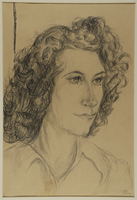
Portrait of woman with long curly hair by a German Jewish internee
Object
Portrait of a woman at Gurs internment camp, drawn by Lili Andrieux, a German Jewish internee. Lili created over 100 detailed drawings of people and daily life in the internment camps where she was held from May 1940 - September 1942 in France. Alençon was a collection center for transport to Camp de Gurs in Vichy France. After surrendering to Nazi Germany in June 1940, France was divided into two zones: a German military occupation zone and Free France under the Vichy regime. Gurs, built in spring 1939 to hold refugees from Spain, became an internment center for Jewish refugees. Lili, originally from Berlin, moved to Paris in 1938. She was taken to Alençon in May 1940 and reached Gurs on June 4. From March 1941-September 1942, she was held in the Hotel Terminus in Marseilles waiting for a visa. She was then sent to Les Milles internment camp where she became ill with typhus. When she recovered, she escaped and, with the help of the resistance, lived in hiding until fall 1944, when the war ended in France. Lili was a translator for the US Army and US Graves Registration Command until immigrating to America in September 1946.
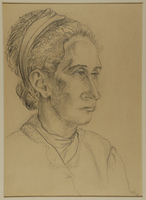
Portrait of woman with hair pulled back by a German Jewish internee
Object
Portrait of a woman at Gurs internment camp, drawn by Lili Andrieux, a German Jewish internee. Lili created over 100 detailed drawings of people and daily life in the internment camps where she was held from May 1940 - September 1942 in France. Alençon was a collection center for transport to Camp de Gurs in Vichy France. After surrendering to Nazi Germany in June 1940, France was divided into two zones: a German military occupation zone and Free France under the Vichy regime. Gurs, built in spring 1939 to hold refugees from Spain, became an internment center for Jewish refugees. Lili, originally from Berlin, moved to Paris in 1938. She was taken to Alençon in May 1940 and reached Gurs on June 4. From March 1941-September 1942, she was held in the Hotel Terminus in Marseilles waiting for a visa. She was then sent to Les Milles internment camp where she became ill with typhus. When she recovered, she escaped and, with the help of the resistance, lived in hiding until fall 1944, when the war ended in France. Lili was a translator for the US Army and US Graves Registration Command until immigrating to America in September 1946.
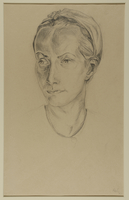
Portrait of woman with hair in a scarf by a German Jewish internee
Object
Portrait of a woman at Gurs internment camp, drawn by Lili Andrieux, a German Jewish internee. Lili created over 100 detailed drawings of people and daily life in the internment camps where she was held from May 1940 - September 1942 in France. Alençon was a collection center for transport to Camp de Gurs in Vichy France. After surrendering to Nazi Germany in June 1940, France was divided into two zones: a German military occupation zone and Free France under the Vichy regime. Gurs, built in spring 1939 to hold refugees from Spain, became an internment center for Jewish refugees. Lili, originally from Berlin, moved to Paris in 1938. She was taken to Alençon in May 1940 and reached Gurs on June 4. From March 1941-September 1942, she was held in the Hotel Terminus in Marseilles waiting for a visa. She was then sent to Les Milles internment camp where she became ill with typhus. When she recovered, she escaped and, with the help of the resistance, lived in hiding until fall 1944, when the war ended in France. Lili was a translator for the US Army and US Graves Registration Command until immigrating to America in September 1946.
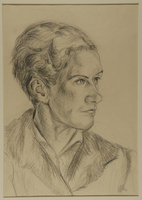
Portrait of young woman with short hair by a German Jewish internee
Object
Portrait of a woman at Gurs internment camp, drawn by Lili Andrieux, a German Jewish internee. Lili created over 100 detailed drawings of people and daily life in the internment camps where she was held from May 1940 - September 1942 in France. Alençon was a collection center for transport to Camp de Gurs in Vichy France. After surrendering to Nazi Germany in June 1940, France was divided into two zones: a German military occupation zone and Free France under the Vichy regime. Gurs, built in spring 1939 to hold refugees from Spain, became an internment center for Jewish refugees. Lili, originally from Berlin, moved to Paris in 1938. She was taken to Alençon in May 1940 and reached Gurs on June 4. From March 1941-September 1942, she was held in the Hotel Terminus in Marseilles waiting for a visa. She was then sent to Les Milles internment camp where she became ill with typhus. When she recovered, she escaped and, with the help of the resistance, lived in hiding until fall 1944, when the war ended in France. Lili was a translator for the US Army and US Graves Registration Command until immigrating to America in September 1946.
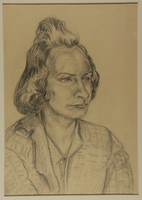
Portrait of a young woman with short hair by a German Jewish internee
Object
Portrait of a young woman at Gurs internment camp, drawn by Lili Andrieux, a German Jewish internee. Lili created over 100 detailed drawings of people and daily life in the internment camps where she was held from May 1940 - September 1942 in France. Alençon was a collection center for transport to Camp de Gurs in Vichy France. After surrendering to Nazi Germany in June 1940, France was divided into two zones: a German military occupation zone and Free France under the Vichy regime. Gurs, built in spring 1939 to hold refugees from Spain, became an internment center for Jewish refugees. Lili, originally from Berlin, moved to Paris in 1938. She was taken to Alençon in May 1940 and reached Gurs on June 4. From March 1941-September 1942, she was held in the Hotel Terminus in Marseilles waiting for a visa. She was then sent to Les Milles internment camp where she became ill with typhus. When she recovered, she escaped and, with the help of the resistance, lived in hiding until fall 1944, when the war ended in France. Lili was a translator for the US Army and US Graves Registration Command until immigrating to America in September 1946.
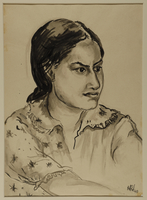
Portrait of a young Hindu woman by a German Jewish internee
Object
Portrait of a young Hindu woman at Gurs internment camp, drawn by Lili Andrieux, a German Jewish internee. Lili created over 100 detailed drawings of people and daily life in the internment camps where she was held from May 1940 - September 1942 in France. Alençon was a collection center for transport to Camp de Gurs in Vichy France. After surrendering to Nazi Germany in June 1940, France was divided into two zones: a German military occupation zone and Free France under the Vichy regime. Gurs, built in spring 1939 to hold refugees from Spain, became an internment center for Jewish refugees. Lili, originally from Berlin, moved to Paris in 1938. She was taken to Alençon in May 1940 and reached Gurs on June 4. From March 1941-September 1942, she was held in the Hotel Terminus in Marseilles waiting for a visa. She was then sent to Les Milles internment camp where she became ill with typhus. When she recovered, she escaped and, with the help of the resistance, lived in hiding until fall 1944, when the war ended in France. Lili was a translator for the US Army and US Graves Registration Command until immigrating to America in September 1946.
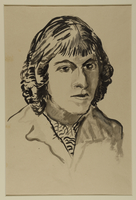
Self-portrait by a German Jewish internee
Object
Self-portrait of Lili Andrieux, a German Jewish internee at Gurs internment camp. Lili created over 100 detailed drawings of people and daily life in the internment camps where she was held from May 1940 - September 1942 in France. Alençon was a collection center for transport to Camp de Gurs in Vichy France. After surrendering to Nazi Germany in June 1940, France was divided into two zones: a German military occupation zone and Free France under the Vichy regime. Gurs, built in spring 1939 to hold refugees from Spain, became an internment center for Jewish refugees. Lili, originally from Berlin, moved to Paris in 1938. She was taken to Alençon in May 1940 and reached Gurs on June 4. From March 1941-September 1942, she was held in the Hotel Terminus in Marseilles waiting for a visa. She was then sent to Les Milles internment camp where she became ill with typhus. When she recovered, she escaped and, with the help of the resistance, lived in hiding until fall 1944, when the war ended in France. Lili was a translator for the US Army and US Graves Registration Command until immigrating to America in September 1946.
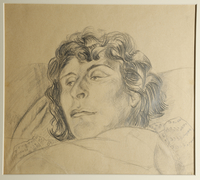
Portrait of a woman by a German Jewish internee
Object
Drawing by Lili Andrieux, a German Jewish internee. Lili created over 100 detailed drawings of people and daily life in the internment camps where she was held from May 1940 - September 1942 in France. Alençon was a collection center for transport to Camp de Gurs in Vichy France. After surrendering to Nazi Germany in June 1940, France was divided into two zones: a German military occupation zone and Free France under the Vichy regime. Gurs, built in spring 1939 to hold refugees from Spain, became an internment center for Jewish refugees. Lili, originally from Berlin, moved to Paris in 1938. She was taken to Alençon in May 1940 and reached Gurs on June 4. From March 1941-September 1942, she was held in the Hotel Terminus in Marseilles waiting for a visa. She was then sent to Les Milles internment camp where she became ill with typhus. When she recovered, she escaped and, with the help of the resistance, lived in hiding until fall 1944, when the war ended in France. Lili was a translator for the US Army and US Graves Registration Command until immigrating to America in September 1946.
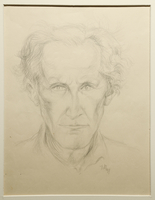
Portrait of an older man by a German Jewish internee
Object
Drawing by Lili Andrieux, a German Jewish internee. Lili created over 100 detailed drawings of people and daily life in the internment camps where she was held from May 1940 - September 1942 in France. Alençon was a collection center for transport to Camp de Gurs in Vichy France. After surrendering to Nazi Germany in June 1940, France was divided into two zones: a German military occupation zone and Free France under the Vichy regime. Gurs, built in spring 1939 to hold refugees from Spain, became an internment center for Jewish refugees. Lili, originally from Berlin, moved to Paris in 1938. She was taken to Alençon in May 1940 and reached Gurs on June 4. From March 1941-September 1942, she was held in the Hotel Terminus in Marseilles waiting for a visa. She was then sent to Les Milles internment camp where she became ill with typhus. When she recovered, she escaped and, with the help of the resistance, lived in hiding until fall 1944, when the war ended in France. Lili was a translator for the US Army and US Graves Registration Command until immigrating to America in September 1946.
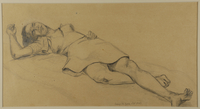
Drawing of a woman sleeping on her back by a German Jewish internee
Object
Drawing of an exhausted woman at Gurs internment camp, drawn by Lili Andrieux, a German Jewish internee. Lili created over 100 detailed drawings of people and daily life in the internment camps where she was held from May 1940 - September 1942 in France. Alençon was a collection center for transport to Camp de Gurs in Vichy France. After surrendering to Nazi Germany in June 1940, France was divided into two zones: a German military occupation zone and Free France under the Vichy regime. Gurs, built in spring 1939 to hold refugees from Spain, became an internment center for Jewish refugees. Lili, originally from Berlin, moved to Paris in 1938. She was taken to Alençon in May 1940 and reached Gurs on June 4. From March 1941-September 1942, she was held in the Hotel Terminus in Marseilles waiting for a visa. She was then sent to Les Milles internment camp where she became ill with typhus. When she recovered, she escaped and, with the help of the resistance, lived in hiding until fall 1944, when the war ended in France. Lili was a translator for the US Army and US Graves Registration Command until immigrating to America in September 1946.
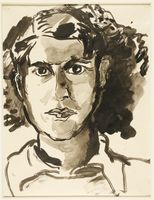
Portrait in profile of a woman by a German Jewish internee
Object
Drawing by Lili Andrieux, a German Jewish internee. Lili created over 100 detailed drawings of people and daily life in the internment camps where she was held from May 1940 - September 1942 in France. Alençon was a collection center for transport to Camp de Gurs in Vichy France. After surrendering to Nazi Germany in June 1940, France was divided into two zones: a German military occupation zone and Free France under the Vichy regime. Gurs, built in spring 1939 to hold refugees from Spain, became an internment center for Jewish refugees. Lili, originally from Berlin, moved to Paris in 1938. She was taken to Alençon in May 1940 and reached Gurs on June 4. From March 1941-September 1942, she was held in the Hotel Terminus in Marseilles waiting for a visa. She was then sent to Les Milles internment camp where she became ill with typhus. When she recovered, she escaped and, with the help of the resistance, lived in hiding until fall 1944, when the war ended in France. Lili was a translator for the US Army and US Graves Registration Command until immigrating to America in September 1946.
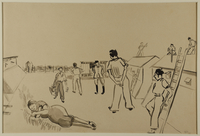
Drawing of a scene outside barracks by a German Jewish internee
Object
Drawing of an outdoor scene at Gurs internment camp by Lili Andrieux, a German Jewish internee. Lili created over 100 detailed drawings of people and daily life in the internment camps where she was held from May 1940 - September 1942 in France. Alençon was a collection center for transport to Camp de Gurs in Vichy France. After surrendering to Nazi Germany in June 1940, France was divided into two zones: a German military occupation zone and Free France under the Vichy regime. Gurs, built in spring 1939 to hold refugees from Spain, became an internment center for Jewish refugees. Lili, originally from Berlin, moved to Paris in 1938. She was taken to Alençon in May 1940 and reached Gurs on June 4. From March 1941-September 1942, she was held in the Hotel Terminus in Marseilles waiting for a visa. She was then sent to Les Milles internment camp where she became ill with typhus. When she recovered, she escaped and, with the help of the resistance, lived in hiding until fall 1944, when the war ended in France. Lili was a translator for the US Army and US Graves Registration Command until immigrating to America in September 1946.
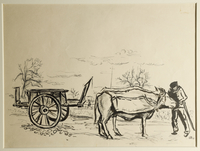
Drawing of an ox-drawn wagon by a German Jewish internee
Object
Drawing by Lili Andrieux, a German Jewish internee. Lili created over 100 detailed drawings of people and daily life in the internment camps where she was held from May 1940 - September 1942 in France. Alençon was a collection center for transport to Camp de Gurs in Vichy France. After surrendering to Nazi Germany in June 1940, France was divided into two zones: a German military occupation zone and Free France under the Vichy regime. Gurs, built in spring 1939 to hold refugees from Spain, became an internment center for Jewish refugees. Lili, originally from Berlin, moved to Paris in 1938. She was taken to Alençon in May 1940 and reached Gurs on June 4. From March 1941-September 1942, she was held in the Hotel Terminus in Marseilles waiting for a visa. She was then sent to Les Milles internment camp where she became ill with typhus. When she recovered, she escaped and, with the help of the resistance, lived in hiding until fall 1944, when the war ended in France. Lili was a translator for the US Army and US Graves Registration Command until immigrating to America in September 1946.

Drawing of a seated man by a German Jewish internee
Object
Drawing by Lili Andrieux, a German Jewish internee. Lili created over 100 detailed drawings of people and daily life in the internment camps where she was held from May 1940 - September 1942 in France. Alençon was a collection center for transport to Camp de Gurs in Vichy France. After surrendering to Nazi Germany in June 1940, France was divided into two zones: a German military occupation zone and Free France under the Vichy regime. Gurs, built in spring 1939 to hold refugees from Spain, became an internment center for Jewish refugees. Lili, originally from Berlin, moved to Paris in 1938. She was taken to Alençon in May 1940 and reached Gurs on June 4. From March 1941-September 1942, she was held in the Hotel Terminus in Marseilles waiting for a visa. She was then sent to Les Milles internment camp where she became ill with typhus. When she recovered, she escaped and, with the help of the resistance, lived in hiding until fall 1944, when the war ended in France. Lili was a translator for the US Army and US Graves Registration Command until immigrating to America in September 1946.
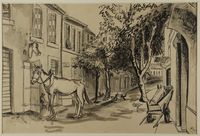
Drawing of a street scene by a German Jewish internee
Object
Drawing of a street scene by Lili Andrieux, a German Jewish internee at Hotel Terminus du Port, Marseille, France. Lili created over 100 detailed drawings of people and daily life in the internment camps where she was held from May 1940 - September 1942 in France. Alençon was a collection center for transport to Camp de Gurs in Vichy France. After surrendering to Nazi Germany in June 1940, France was divided into two zones: a German military occupation zone and Free France under the Vichy regime. Gurs, built in spring 1939 to hold refugees from Spain, became an internment center for Jewish refugees. Lili, originally from Berlin, moved to Paris in 1938. She was taken to Alençon in May 1940 and reached Gurs on June 4. From March 1941-September 1942, she was held in the Hotel Terminus in Marseilles waiting for a visa. She was then sent to Les Milles internment camp where she became ill with typhus. When she recovered, she escaped and, with the help of the resistance, lived in hiding until fall 1944, when the war ended in France. Lili was a translator for the US Army and US Graves Registration Command until immigrating to America in September 1946.
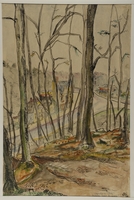
Watercolor and ink landscape by a German Jewish internee
Object
Watercolor and ink landscape, drawn by Lili Andrieux, a German Jewish internee. Lili created over 100 detailed drawings of people and daily life in the internment camps where she was held from May 1940 - September 1942 in France. Alençon was a collection center for transport to Camp de Gurs in Vichy France. After surrendering to Nazi Germany in June 1940, France was divided into two zones: a German military occupation zone and Free France under the Vichy regime. Gurs, built in spring 1939 to hold refugees from Spain, became an internment center for Jewish refugees. Lili, originally from Berlin, moved to Paris in 1938. She was taken to Alençon in May 1940 and reached Gurs on June 4. From March 1941-September 1942, she was held in the Hotel Terminus in Marseilles waiting for a visa. She was then sent to Les Milles internment camp where she became ill with typhus. When she recovered, she escaped and, with the help of the resistance, lived in hiding until fall 1944, when the war ended in France. Lili was a translator for the US Army and US Graves Registration Command until immigrating to America in September 1946.
Drawing of two women in undergarments relaxing on a mattress by by a German Jewish internee
Object
Sketch of two women in Gurs internment camp, drawn by Lili Andrieux, a German Jewish internee. Lili created over 100 detailed drawings of people and daily life in the internment camps where she was held from May 1940 - September 1942 in France. Alençon was a collection center for transport to Camp de Gurs in Vichy France. After surrendering to Nazi Germany in June 1940, France was divided into two zones: a German military occupation zone and Free France under the Vichy regime. Gurs, built in spring 1939 to hold refugees from Spain, became an internment center for Jewish refugees. Lili, originally from Berlin, moved to Paris in 1938. She was taken to Alençon in May 1940 and reached Gurs on June 4. From March 1941-September 1942, she was held in the Hotel Terminus in Marseilles waiting for a visa. She was then sent to Les Milles internment camp where she became ill with typhus. When she recovered, she escaped and, with the help of the resistance, lived in hiding until fall 1944, when the war ended in France. Lili was a translator for the US Army and US Graves Registration Command until immigrating to America in September 1946.
Two-sided drawing of bunk space and two men by by a German Jewish internee
Object
Double-sided sketch of a bunk and two men in Gurs internment camp, drawn by Lili Andrieux, a German Jewish internee. Lili created over 100 detailed drawings of people and daily life in the internment camps where she was held from May 1940 - September 1942 in France. Alençon was a collection center for transport to Camp de Gurs in Vichy France. After surrendering to Nazi Germany in June 1940, France was divided into two zones: a German military occupation zone and Free France under the Vichy regime. Gurs, built in spring 1939 to hold refugees from Spain, became an internment center for Jewish refugees. Lili, originally from Berlin, moved to Paris in 1938. She was taken to Alençon in May 1940 and reached Gurs on June 4. From March 1941-September 1942, she was held in the Hotel Terminus in Marseilles waiting for a visa. She was then sent to Les Milles internment camp where she became ill with typhus. When she recovered, she escaped and, with the help of the resistance, lived in hiding until fall 1944, when the war ended in France. Lili was a translator for the US Army and US Graves Registration Command until immigrating to America in September 1946.
Black ink wash drawing of woodcutters by a German Jewish internee
Object
Drawing of woodcutters in Gurs internment camp, drawn by Lili Andrieux, a German Jewish internee. Lili created over 100 detailed drawings of people and daily life in the internment camps where she was held from May 1940 - September 1942 in France. Alençon was a collection center for transport to Camp de Gurs in Vichy France. After surrendering to Nazi Germany in June 1940, France was divided into two zones: a German military occupation zone and Free France under the Vichy regime. Gurs, built in spring 1939 to hold refugees from Spain, became an internment center for Jewish refugees. Lili, originally from Berlin, moved to Paris in 1938. She was taken to Alençon in May 1940 and reached Gurs on June 4. From March 1941-September 1942, she was held in the Hotel Terminus in Marseilles waiting for a visa. She was then sent to Les Milles internment camp where she became ill with typhus. When she recovered, she escaped and, with the help of the resistance, lived in hiding until fall 1944, when the war ended in France. Lili was a translator for the US Army and US Graves Registration Command until immigrating to America in September 1946.
Drawing of three men around a table by a German Jewish internee
Object
Drawing of men in a canteen, drawn by Lili Andrieux, a German Jewish internee. Lili created over 100 detailed drawings of people and daily life in the internment camps where she was held from May 1940 - September 1942 in France. Alençon was a collection center for transport to Camp de Gurs in Vichy France. After surrendering to Nazi Germany in June 1940, France was divided into two zones: a German military occupation zone and Free France under the Vichy regime. Gurs, built in spring 1939 to hold refugees from Spain, became an internment center for Jewish refugees. Lili, originally from Berlin, moved to Paris in 1938. She was taken to Alençon in May 1940 and reached Gurs on June 4. From March 1941-September 1942, she was held in the Hotel Terminus in Marseilles waiting for a visa. She was then sent to Les Milles internment camp where she became ill with typhus. When she recovered, she escaped and, with the help of the resistance, lived in hiding until fall 1944, when the war ended in France. Lili was a translator for the US Army and US Graves Registration Command until immigrating to America in September 1946.
Drawing of multiple people gathered outside by a German Jewish internee
Object
Ink drawing of Spanish refugees in Gurs internment camp, drawn by Lili Andrieux, a German Jewish internee. Lili created over 100 detailed drawings of people and daily life in the internment camps where she was held from May 1940 - September 1942 in France. Alençon was a collection center for transport to Camp de Gurs in Vichy, France. After surrendering to Nazi Germany in June 1940, France was divided into two zones: a German military occupation zone and Free France under the Vichy regime. Gurs, built in spring 1939 to hold refugees from Spain, became an internment center for Jewish refugees. Lili, originally from Berlin, moved to Paris in 1938. She was taken to Alençon in May 1940 and reached Gurs on June 4. From March 1941-September 1942, she was held in the Hotel Terminus in Marseilles waiting for a visa. Lili was then sent to Les Milles internment camp where she became ill with typhus. After recovering, she escaped with the help of the resistance, and lived in hiding until fall 1944, when the war ended in France. Lili was a translator for the US Army and US Graves Registration Command until immigrating to America in September 1946.
Drawing of a man sitting with two women by a German Jewish internee
Object
Ink drawing of a man and two women sitting together in the women’s barracks at Gurs internment camp, drawn by Lili Andrieux, a German Jewish internee. Lili created over 100 detailed drawings of people and daily life in the internment camps where she was held from May 1940 - September 1942 in France. Alençon was a collection center for transport to Camp de Gurs in Vichy, France. After surrendering to Nazi Germany in June 1940, France was divided into two zones: a German military occupation zone and Free France under the Vichy regime. Gurs, built in spring 1939 to hold refugees from Spain, became an internment center for Jewish refugees. Lili, originally from Berlin, moved to Paris in 1938. She was taken to Alençon in May 1940 and reached Gurs on June 4. From March 1941-September 1942, she was held in the Hotel Terminus in Marseilles waiting for a visa. Lili was then sent to Les Milles internment camp where she became ill with typhus. After recovering, she escaped with the help of the resistance, and lived in hiding until fall 1944, when the war ended in France. Lili was a translator for the US Army and US Graves Registration Command until immigrating to America in September 1946.
Drawing of men working on a roof by a German Jewish internee
Object
Ink drawing of Spanish refugees working on the women’s barracks at Gurs internment camp, drawn by Lili Andrieux, a German Jewish internee. Lili created over 100 detailed drawings of people and daily life in the internment camps where she was held from May 1940 - September 1942 in France. Alençon was a collection center for transport to Camp de Gurs in Vichy, France. After surrendering to Nazi Germany in June 1940, France was divided into two zones: a German military occupation zone and Free France under the Vichy regime. Gurs, built in spring 1939 to hold refugees from Spain, became an internment center for Jewish refugees. Lili, originally from Berlin, moved to Paris in 1938. She was taken to Alençon in May 1940 and reached Gurs on June 4. From March 1941-September 1942, she was held in the Hotel Terminus in Marseilles waiting for a visa. Lili was then sent to Les Milles internment camp where she became ill with typhus. After recovering, she escaped with the help of the resistance, and lived in hiding until fall 1944, when the war ended in France. Lili was a translator for the US Army and US Graves Registration Command until immigrating to America in September 1946.
Drawing of men working and sitting outside of a building by a German Jewish internee
Object
Ink drawing of Spanish refugees in Gurs internment camp, drawn by Lili Andrieux, a German Jewish internee. Lili created over 100 detailed drawings of people and daily life in the internment camps where she was held from May 1940 - September 1942 in France. Alençon was a collection center for transport to Camp de Gurs in Vichy, France. After surrendering to Nazi Germany in June 1940, France was divided into two zones: a German military occupation zone and Free France under the Vichy regime. Gurs, built in spring 1939 to hold refugees from Spain, became an internment center for Jewish refugees. Lili, originally from Berlin, moved to Paris in 1938. She was taken to Alençon in May 1940 and reached Gurs on June 4. From March 1941-September 1942, she was held in the Hotel Terminus in Marseilles waiting for a visa. Lili was then sent to Les Milles internment camp where she became ill with typhus. After recovering, she escaped with the help of the resistance, and lived in hiding until fall 1944, when the war ended in France. Lili was a translator for the US Army and US Graves Registration Command until immigrating to America in September 1946.
Drawing of five women inside the barracks by a German Jewish internee
Object
Ink drawing of five women inside the barracks at Gurs internment camp, drawn by Lili Andrieux, a German Jewish internee. Lili created over 100 detailed drawings of people and daily life in the internment camps where she was held from May 1940 - September 1942 in France. Alençon was a collection center for transport to Camp de Gurs in Vichy, France. After surrendering to Nazi Germany in June 1940, France was divided into two zones: a German military occupation zone and Free France under the Vichy regime. Gurs, built in spring 1939 to hold refugees from Spain, became an internment center for Jewish refugees. Lili, originally from Berlin, moved to Paris in 1938. She was taken to Alençon in May 1940 and reached Gurs on June 4. From March 1941-September 1942, she was held in the Hotel Terminus in Marseilles waiting for a visa. Lili was then sent to Les Milles internment camp where she became ill with typhus. After recovering, she escaped with the help of the resistance, and lived in hiding until fall 1944, when the war ended in France. Lili was a translator for the US Army and US Graves Registration Command until immigrating to America in September 1946.
Drawing of five women doing laundry by a German Jewish internee
Object
Ink drawing of five women doing laundry at Gurs internment camp, drawn by Lili Andrieux, a German Jewish internee. Lili created over 100 detailed drawings of people and daily life in the internment camps where she was held from May 1940 - September 1942 in France. Alençon was a collection center for transport to Camp de Gurs in Vichy, France. After surrendering to Nazi Germany in June 1940, France was divided into two zones: a German military occupation zone and Free France under the Vichy regime. Gurs, built in spring 1939 to hold refugees from Spain, became an internment center for Jewish refugees. Lili, originally from Berlin, moved to Paris in 1938. She was taken to Alençon in May 1940 and reached Gurs on June 4. From March 1941-September 1942, she was held in the Hotel Terminus in Marseilles waiting for a visa. Lili was then sent to Les Milles internment camp where she became ill with typhus. After recovering, she escaped with the help of the resistance, and lived in hiding until fall 1944, when the war ended in France. Lili was a translator for the US Army and US Graves Registration Command until immigrating to America in September 1946.
Drawing of a woman sleeping against bundles by a German Jewish internee
Object
Pencil drawing of a woman sleeping in a cattle-car during transport from Alençon collection center to Gurs internment camp, drawn by Lili Andrieux, a German Jewish internee. Lili created over 100 detailed drawings of people and daily life in the internment camps where she was held from May 1940 - September 1942 in France. Alençon was a collection center for transport to Camp de Gurs in Vichy, France. After surrendering to Nazi Germany in June 1940, France was divided into two zones: a German military occupation zone and Free France under the Vichy regime. Gurs, built in spring 1939 to hold refugees from Spain, became an internment center for Jewish refugees. Lili, originally from Berlin, moved to Paris in 1938. She was taken to Alençon in May 1940 and reached Gurs on June 4. From March 1941-September 1942, she was held in the Hotel Terminus in Marseilles waiting for a visa. Lili was then sent to Les Milles internment camp where she became ill with typhus. After recovering, she escaped with the help of the resistance, and lived in hiding until fall 1944, when the war ended in France. Lili was a translator for the US Army and US Graves Registration Command until immigrating to America in September 1946.
Drawing of a man wearing a jacket by a German Jewish internee
Object
Ink drawing of a Spanish refugee in Les Milles internment camp, drawn by Lili Andrieux, a German Jewish internee. Lili created over 100 detailed drawings of people and daily life in the internment camps where she was held from May 1940 - September 1942 in France. Alençon was a collection center for transport to Camp de Gurs in Vichy, France. After surrendering to Nazi Germany in June 1940, France was divided into two zones: a German military occupation zone and Free France under the Vichy regime. Gurs, built in spring 1939 to hold refugees from Spain, became an internment center for Jewish refugees. Lili, originally from Berlin, moved to Paris in 1938. She was taken to Alençon in May 1940 and reached Gurs on June 4. From March 1941-September 1942, she was held in the Hotel Terminus waiting for a visa. Lili was then sent to Les Milles where she became ill with typhus. After recovering, she escaped with the help of the resistance, and lived in hiding until fall 1944, when the war ended in France. Lili was a translator for the US Army and US Graves Registration Command until immigrating to America in September 1946.
Drawing of a man by a German Jewish internee
Object
Drawing by Lili Andrieux, a German Jewish internee. Lili created over 100 detailed drawings of people and daily life in the internment camps where she was held from May 1940 - September 1942 in France. Alençon was a collection center for transport to Camp de Gurs in Vichy France. After surrendering to Nazi Germany in June 1940, France was divided into two zones: a German military occupation zone and Free France under the Vichy regime. Gurs, built in spring 1939 to hold refugees from Spain, became an internment center for Jewish refugees. Lili, originally from Berlin, moved to Paris in 1938. She was taken to Alençon in May 1940 and reached Gurs on June 4. From March 1941-September 1942, she was held in the Hotel Terminus in Marseilles waiting for a visa. She was then sent to Les Milles internment camp where she became ill with typhus. When she recovered, she escaped and, with the help of the resistance, lived in hiding until fall 1944, when the war ended in France. Lili was a translator for the US Army and US Graves Registration Command until immigrating to America in September 1946.



